India’s Direct-to-Consumer (D2C) market is booming, with over 800 brands targeting a market valued at ₹6.6 lakh crore in 2024, projected to reach ₹8.2 lakh crore by 2025 and ₹24.6 lakh crore by 2030. This growth is driven by internet penetration (52% in 2024), rising e-commerce, and changing consumer preferences for personalised, convenient shopping. Below is an overview of 26 standout Indian D2C brands reshaping industries like beauty, personal care, fashion, and more:
Key Brands and Highlights:
- Sugar Cosmetics: Beauty products tailored for Indian skin tones; FY24 revenue of ₹505.10 crore.
- Mamaearth: Natural personal care; FY24 revenue of ₹1,970 crore; valued at $1.2 billion.
- Plum: Vegan, cruelty-free beauty; FY23 revenue of $25 million.
- Wow Skin Science: Natural skincare; FY24 revenue of ₹233.49 crore.
- Lenskart: Eyewear leader; FY24 revenue of ₹5,428 crore; expanding globally.
- Mokobara: Stylish luggage; FY24 revenue of ₹117.44 crore.
- Bewakoof: Quirky fashion; FY22 revenue of ₹157 crore.
- The Souled Store: Pop culture merchandise; FY24 revenue of ₹360 crore.
- Rage Coffee: Premium instant coffee; FY24 revenue of ₹25.1 crore.
- Epigamia: Greek yogurt pioneer; FY23 revenue of ₹172 crore.
- SleepyCat: Mattress-in-a-box innovator; FY23 revenue of ₹55 crore.
- Wakefit: Home furnishings; FY24 revenue of ₹1,000 crore.
- Oziva: Plant-based nutrition; scaled to ₹400 crore ARR post-HUL acquisition.
- The Whole Truth: Clean-label snacks; FY25 revenue of ₹200 crore.
- boAt: Affordable audio products; FY24 revenue of ₹2,459.2 crore.
- Noise: Wearables; FY24 revenue of ₹1,431 crore.
- Phool: Eco-friendly products from temple waste; FY24 revenue of ₹50 crore.
- Minimalist: Transparent skincare; FY24 revenue of ₹350 crore.
- mCaffeine: Caffeine-infused personal care; FY23 revenue of ₹205.3 crore.
- Bombay Shaving Company: Grooming solutions; FY25 revenue of ₹300 crore.
- Bluestone: Jewellery; FY24 revenue of ₹1,265.84 crore.
- Zivame: Intimatewear; acquired by Reliance Retail for ₹1,200 crore.
- Clovia: Lingerie and activewear; FY23 revenue of ₹291.71 crore.
These brands are leveraging digital-first strategies, innovative product offerings, and strong customer engagement to thrive in India’s evolving retail landscape.
Indian D2C Brands Database
Access our curated list of 1300+ Indian D2C brands with comprehensive data for lead sourcing, market research, and brand partnerships.
1. Sugar Cosmetics
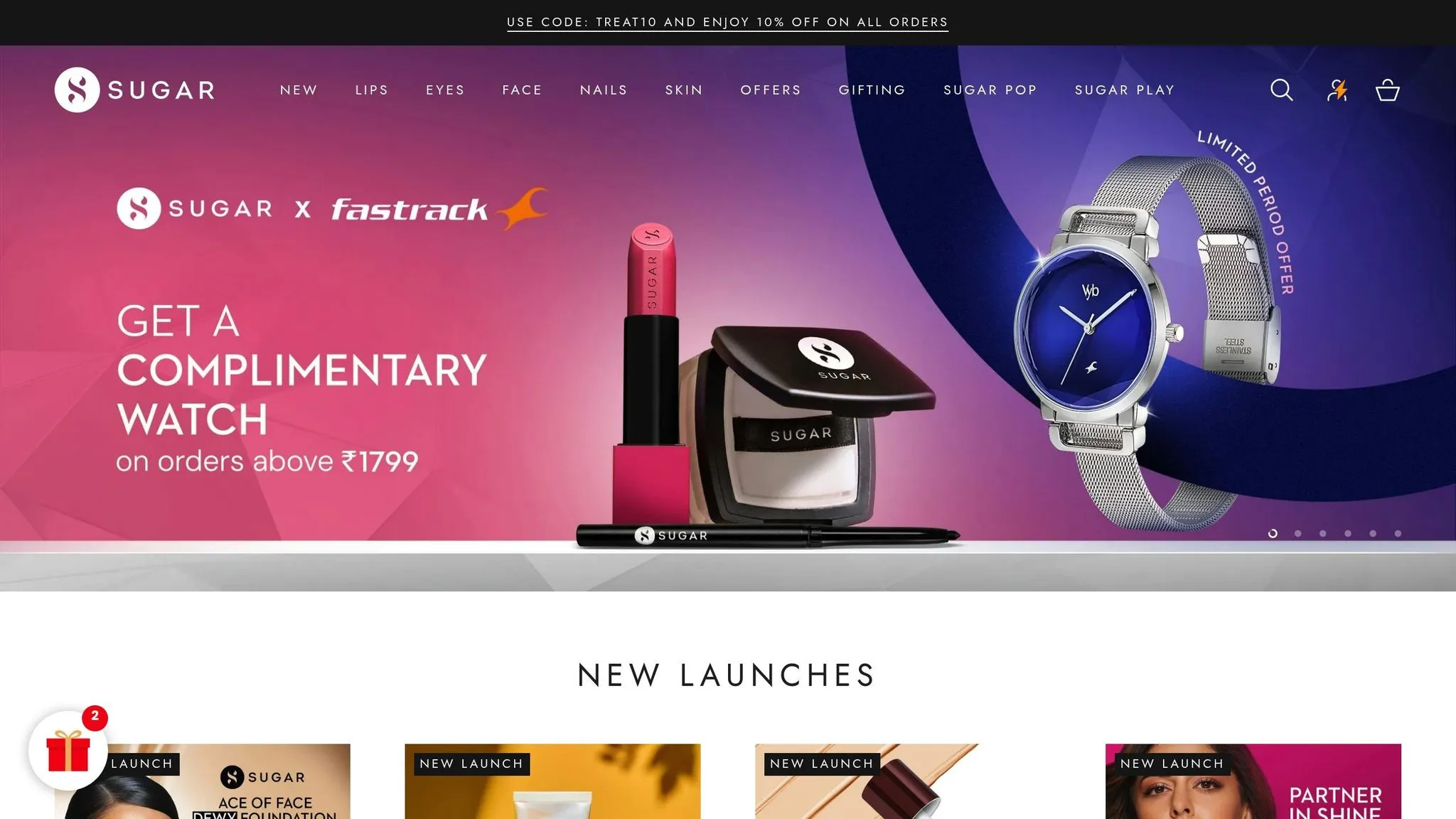
Sugar Cosmetics has emerged as one of India’s top beauty D2C brands, transforming itself from a budding startup into a prominent player in the market. Launched in 2015 by Vineeta Singh and Kaushik Mukherjee, the brand has earned its name by crafting makeup products specifically suited to Indian skin tones. This unique focus has fueled its rapid rise in the competitive D2C beauty space.
Impressive Revenue Growth in Recent Years
Sugar Cosmetics has seen a remarkable surge in its revenue over the last few years. In FY23, the company doubled its revenue to ₹428 crore. By FY24, it achieved a further 20% increase, reaching ₹505.10 crore. Despite a 15% rise in expenses, the company managed to cut its losses by 11.3%, bringing them down to ₹67.58 crore.
Key Funding Milestones and Investor Support
In May 2022, Sugar Cosmetics secured ₹50 million in funding from a group of investors, including L Catterton, A91 Partners, Elevation Capital, and India Quotient. This financial boost has enabled the brand to scale its operations across e-commerce platforms, quick commerce, and general trade channels. The investment underscores the confidence investors have in Sugar’s omnichannel strategy and its ability to thrive in a beauty market expected to grow at a 36.4% CAGR from 2025 to 2032. The brand’s funding journey and operational strategies reflect the broader growth trends in India’s D2C sector.
Robust Digital Presence and Social Media Impact
Sugar Cosmetics’ strong digital strategy has been a cornerstone of its success. With 90% of its consumers discovering the brand online, its digital-first approach has paid off. The company has amassed nearly 1.5 million Instagram followers and garners over 4 billion media views annually.
“Sugar leverages platforms like Moj, Chingaari, Instagram, YouTube, and Twitter”, says Vineeta Singh.
The brand’s content strategy strikes a balance between education and entertainment, featuring customer-driven content that turns everyday users into influencers.
Product Innovation and Market Positioning
Inclusivity and affordability are at the heart of Sugar Cosmetics’ product strategy. Positioned as “affordable luxury”, the brand caters to the mid-range makeup market, with prices starting at ₹499. Sugar’s commitment to inclusive, cruelty-free, and vegan formulations has helped it connect with a wide audience, with 60% of its revenue coming from markets beyond Tier I cities.
Initially focused on a digital-first model, Sugar has steadily expanded its retail footprint. The brand is now present in over 40,000 outlets across India and has plans to further grow its offline presence.
2. Mamaearth
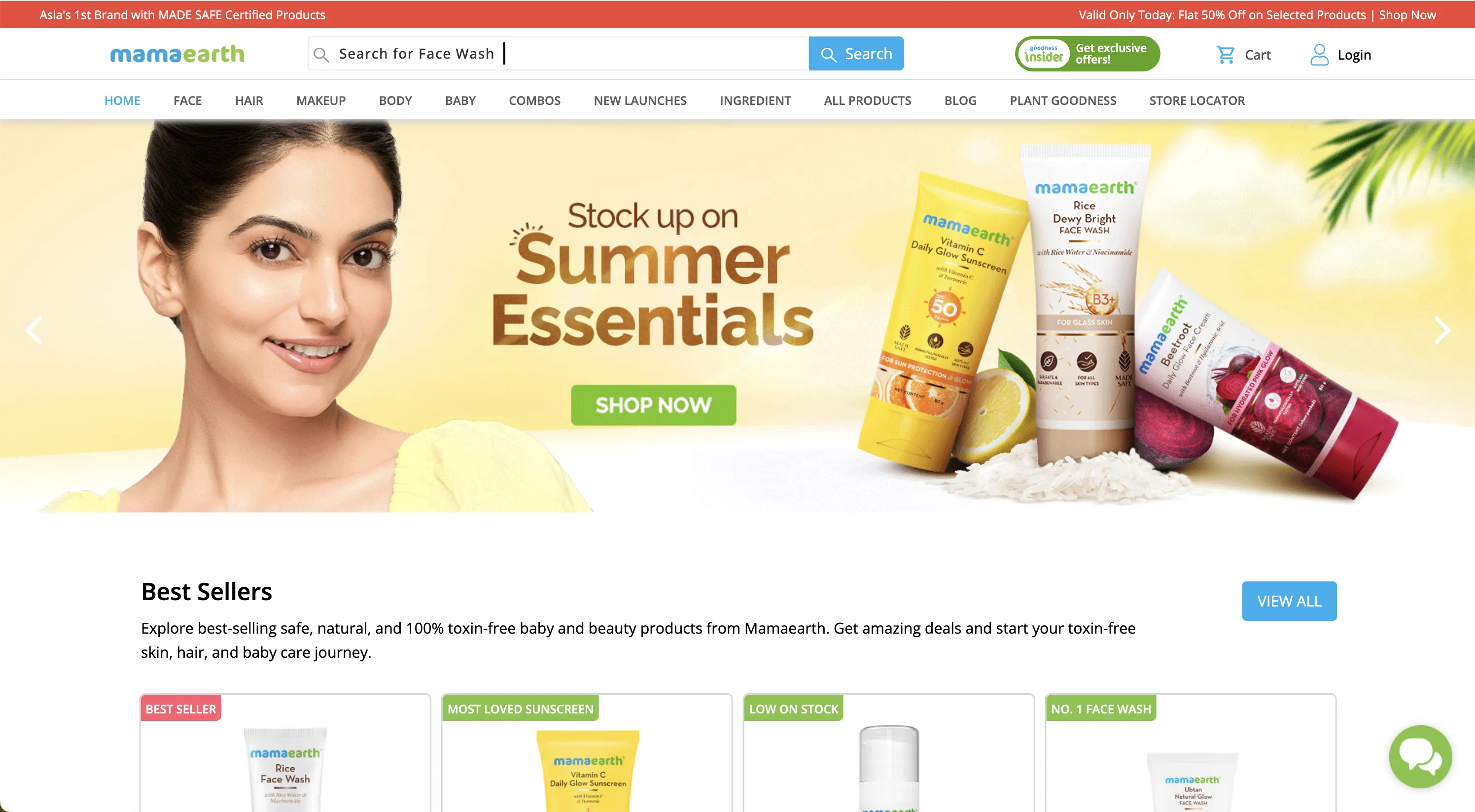
Since its launch in 2016 by Varun and Ghazal Alagh, Mamaearth has become a household name in India’s natural beauty and personal care market. What began as an effort to create safe products for their baby has grown into one of India’s most recognisable direct-to-consumer (D2C) brands. Today, Mamaearth continues to achieve impressive revenue growth year after year.
Rapid Revenue Growth in Recent Years
Mamaearth has seen exceptional growth in the past few years. By March 31, 2024, its annual revenue reached ₹1,970 crore, a sharp rise from ₹1,142 million in FY20. This represents a compound annual growth rate (CAGR) of 103.8%. On the international front, revenue increased from $185.90 million in FY 2023 to $231.91 million in FY 2024. For the trailing 12 months ending March 31, 2025, this figure climbed further to $244.45 million. These numbers illustrate Mamaearth’s ability to maintain steady growth in a competitive market.
Strong Investor Backing and Funding Milestones
Mamaearth has raised $89.4 million across seven funding rounds. A pivotal moment came in July 2021, when the company secured $65.3 million in a Series C round led by investors like Sofina, Evolvence, and Peak XV Partners. This funding enabled the brand to explore international markets and inorganic growth opportunities. Earlier, in January 2020, Mamaearth raised $18.1 million in a Series B round, attracting investors such as Peak XV Partners, Fireside Ventures, and Stellaris Venture Partners. These funding rounds highlight the confidence investors have in Mamaearth’s potential.
Dominating Digital Marketing and Social Media
Mamaearth has embraced digital platforms in a big way, directing 90% of its marketing budget toward online channels. Its website sees 2.76 million organic monthly visits, with 90.9% of traffic coming from mobile devices.
The brand’s social media strategy is centred on building a community and leveraging user-generated content. Campaigns like “#GoodnessMakesYouBeautiful” encouraged customers to share their experiences, creating authentic engagement and boosting credibility. Another standout initiative was the “#PlantGoodness campaign,” where customers were sent geolocations and photos of trees planted for their purchases, tying sustainability to brand loyalty.
“EBOs allow us to create a strong visual connection with the consumers and help us bring the brand promise and experience into the physical world”, says Varun Alagh, Co-founder of Mamaearth.
This digital-first approach has been instrumental in driving Mamaearth’s growth and expanding its product categories.
Expanding Categories and Differentiating Products
Mamaearth’s journey from a baby care brand to a multi-category player is a testament to its strategic vision. While baby care now accounts for just 20% of its revenue, skincare and haircare contribute the remaining 80%. This shift aligns with broader trends in India’s D2C industry.
The brand’s “Goodness Inside” philosophy focuses on safe, eco-friendly products, appealing to health-conscious millennials and Gen Z consumers. By incorporating ingredients like onion, tea tree, and vitamin C, Mamaearth addresses specific concerns while making advanced formulations accessible.
Customer feedback plays a vital role in product development. For example, the brand’s onion-based hair care and vitamin C skincare lines were created in response to consumer demand. Mamaearth also caters to diverse markets by offering smaller pack sizes, such as 100 ml shampoos and 50 ml face washes, addressing varying purchasing capacities.
“You have to obsess about your consumer. Every big decision we made - product lines, packaging, marketing - was guided by what the consumer wanted”, explains Varun Alagh.
Transparency is another cornerstone of Mamaearth’s strategy. By disclosing ingredients and earning certifications like “Made Safe”, the brand has built trust with consumers who are increasingly mindful of what goes into their products. Combined with emotionally compelling campaigns, this approach has solidified Mamaearth’s unique position in India’s crowded beauty and personal care market.
3. Plum
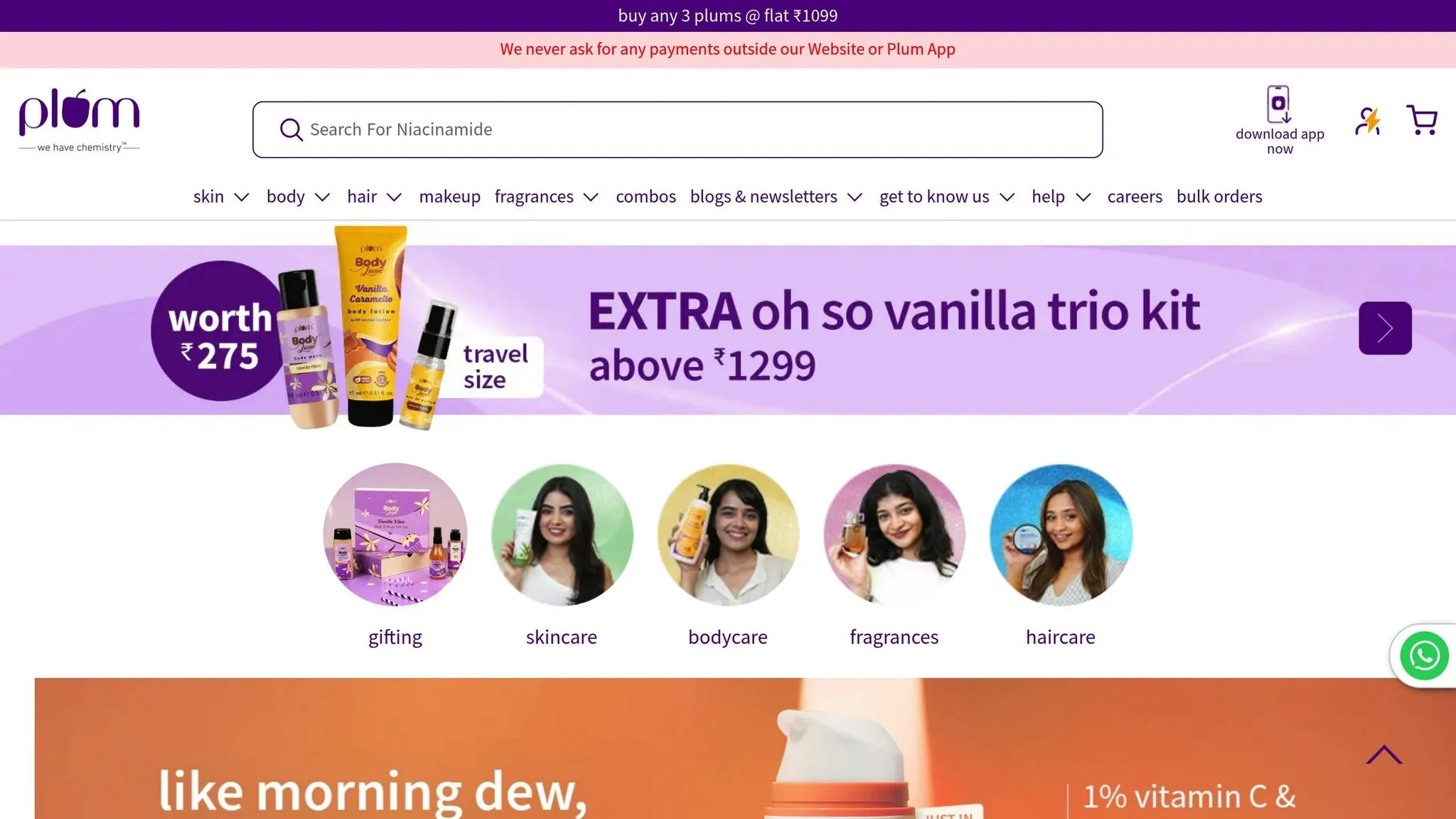
Plum has carved out a prominent spot in India’s bustling beauty and personal care market by blending science-backed formulations with vegan ingredients. The brand has earned a devoted following by staying committed to transparency, effectiveness, and affordability, all while championing cruelty-free beauty practices.
Rapid Revenue Growth in Recent Years
Plum has experienced remarkable financial growth. In 2023, the brand’s revenue surged by 50%, reaching approximately $25 million. Over the past two years, it has consistently achieved 2× year-on-year growth, capturing 15% of the Indian online beauty market and serving more than 2 million active customers. This impressive growth aligns seamlessly with its forward-thinking digital engagement strategies.
Building a Strong Digital Presence
Plum’s digital marketing game is all about connecting with consumers on a personal level. From educational content to influencer partnerships, the brand’s campaigns - like #PlumGoodness and #Empties4Good - emphasise sustainability, authenticity, and consumer engagement. Plum also uses targeted ads on platforms like Facebook and Instagram, while personalising its website to offer ingredient-focused pages and tailored product recommendations. These efforts not only educate shoppers but also build trust. Riding on this digital momentum, Plum has broadened its product range to cater to evolving customer preferences.
Expanding Categories and Standing Out
What started as a skincare brand has grown into a diverse portfolio of over 500 SKUs, including haircare, body care, and makeup products. Plum has evolved from focusing solely on ingredients to creating experiences, all while sticking to clean, vegan formulations and steering clear of harmful chemicals.
“Plum differentiates itself through its unique combination of in-house formulated, science-driven innovations loved by customers, authenticity and approachability as a brand, affordability, and adherence to ethical values.”
“The brand’s emphasis on efficacy, coupled with its transparent communication and affordability, has resonated with consumers, allowing Plum to carve out a niche for itself in the market.”
Plum’s foray into haircare, with products designed to nourish and strengthen Indian hair, and its premium makeup line highlight the brand’s ability to meet the distinct needs of its audience. By continually innovating and staying true to its core values, Plum has solidified its position as a trusted name in the beauty landscape.
4. Wow Skin Science
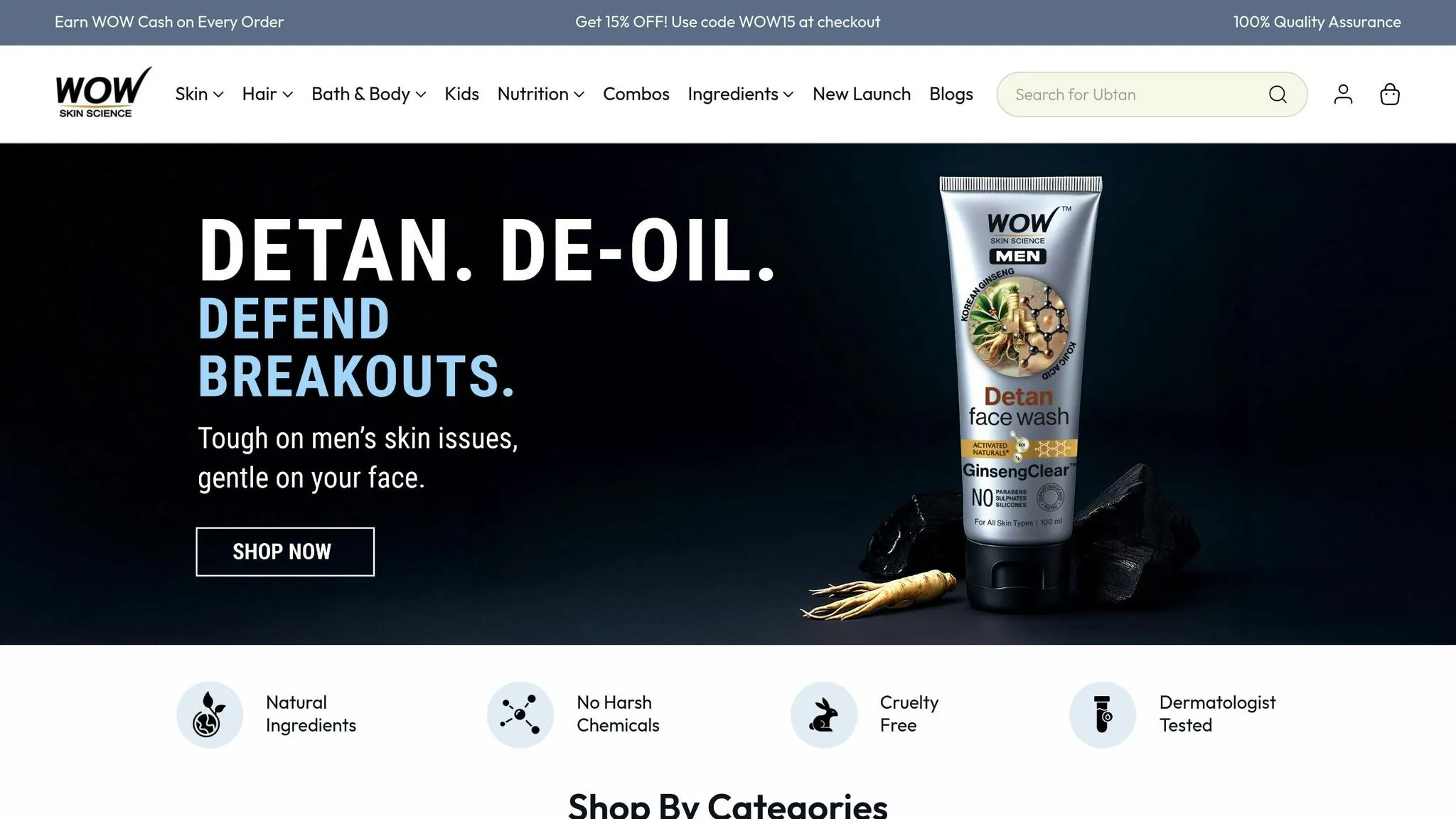
Wow Skin Science has carved out a strong position in India’s beauty and personal care industry with its natural, toxin-free products. As a digital-first brand, its portfolio spans skincare, haircare, and body care, all while upholding cruelty-free and eco-conscious values.
Impressive Revenue Growth Amid Profitability Challenges
Despite facing profitability hurdles, the brand has shown steady growth. In FY24, Wow Skin Science reported revenue of ₹233.49 crore, cut its net loss by 24% to ₹130.2 crore, reduced overall expenses by 22.4% to ₹377 crore, and slashed advertising costs by 46% to ₹107 crore.
“Our primary focus moving forward is achieving sustainable long-term growth with a clear path to profitability. We anticipate further reduction in losses this financial year, aiming to reach near break-even in Q4 and target full profitability in the coming year.” - Manish Chowdhary, cofounder of WOW Skin Science
This financial progress reflects the strength of its digital strategy, which continues to fuel its growth.
A Strong Digital Footprint and Social Media Success
In 2022, over 80% of the brand’s sales came from online platforms. Its Instagram account boasts more than 659K followers. In June 2024, Wow Skin Science collaborated with DRIM for an influencer campaign that involved 75 influencers and 190 publications. This campaign generated over 2.38 million views, 6K+ clicks, and 64K likes, with one reel alone racking up nearly 1.9 million views.
“Online commerce doesn’t have a mechanism to replicate traditional offline channels’ touch, feel, and feedback mechanisms. Influencers provide this critical missing link between online brands and online consumers.” - Vaibhav Arora, Vice President of E-commerce at WOW Skin Science
The brand has also launched creative campaigns like the #TrashYourSpam initiative to address digital pollution and a 2020 campaign featuring Riteish Deshmukh and Genelia D’Souza to highlight its eco-friendly ethos. By working with influencers across all tiers - macro, micro, and nano - and encouraging user-generated content, Wow Skin Science has built a genuine connection with its audience.
Diverse Product Range and Ingredient-Focused Innovations
Wow Skin Science pairs its strong digital presence with a diverse product lineup. It offers over 300 SKUs across categories like face, eyes, lips, body, and hair. Its Apple Cider Vinegar Shampoo has been a standout performer on Amazon in both India and the USA. The brand’s ingredient-driven approach is evident in products like the Onion Black Seed Oil Shampoo for hair fall and the Vitamin C Face Wash for brightening, all free from silicones, parabens, and other harsh chemicals.
“In the last 18 months, we have been recalibrating our story, with a significant focus on brand marketing rather than performance marketing. After all, a brand’s products are manufactured in a factory, but brands are built in the minds of consumers.” - Manish Chowdhary, cofounder of WOW Skin Science
Wow Skin Science has expanded its reach to 22 countries, with a strong focus on the US and South Asia, while maintaining a presence in over 200 cities across India. This international growth showcases its ability to adapt its natural, science-backed formulations to different markets without compromising on its core principles.
5. Lenskart
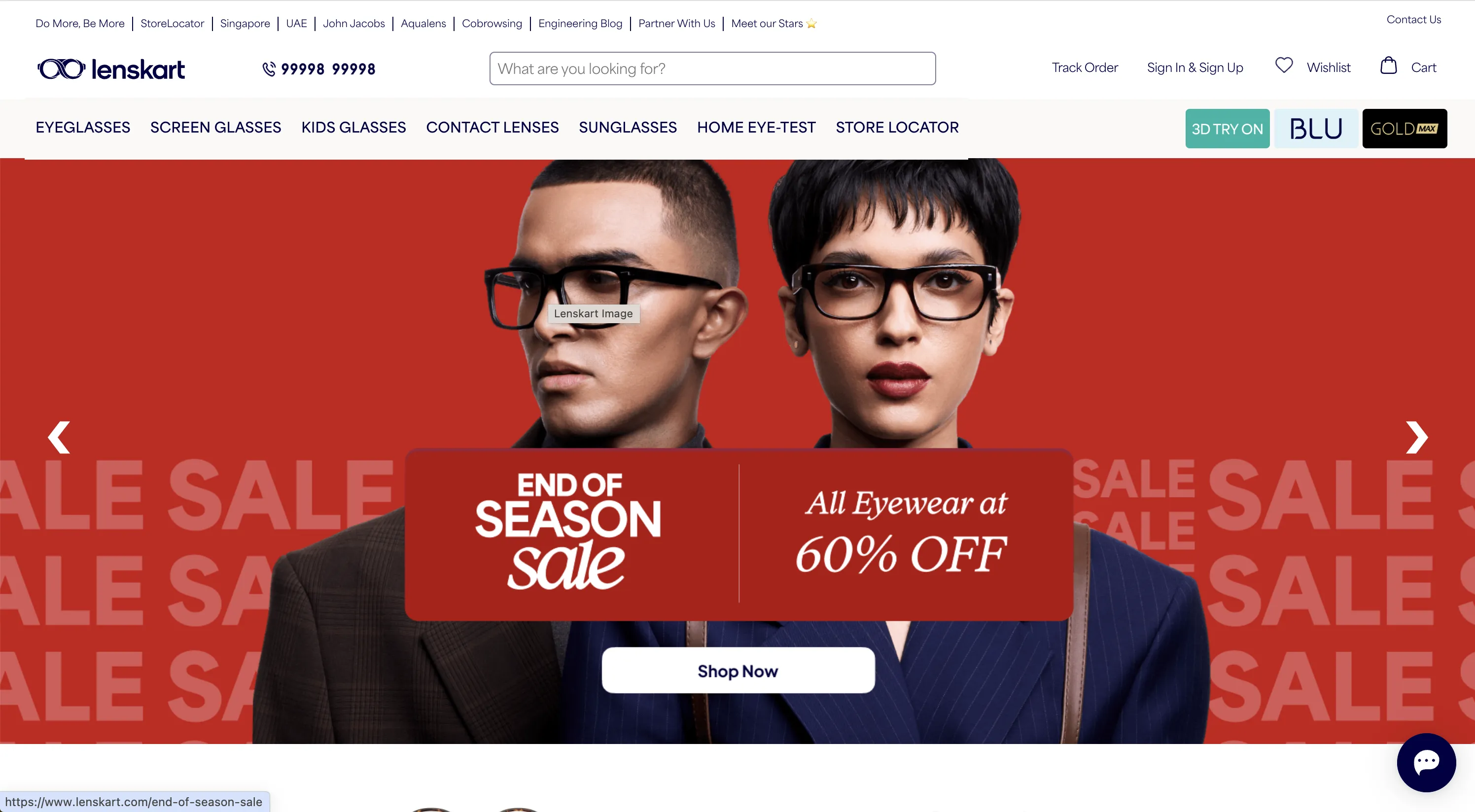
Lenskart is a prime example of how direct-to-consumer (D2C) brands can dominate niche markets. Starting as an online eyewear retailer, it has grown into one of India’s leading eyewear brands, leveraging an omnichannel approach and expanding internationally to fuel its success.
Rapid Revenue Growth Over Recent Years
Lenskart has seen impressive growth in recent years. In FY24, its operating revenue surged by 43% to ₹5,428 crore, while net losses dropped significantly - down 85% to just ₹10 crore from ₹64 crore in FY23. The company is now eyeing an annual revenue run rate of $1 billion (₹8,400 crore) by the close of FY25.
Breaking down the revenue, 58% comes from India, while international markets contribute 42% (₹2,273 crore). Among global markets, Japan has emerged as a standout performer, bringing in ₹782.6 crore in FY24 - a 63% jump from the previous year. Singapore also showed robust growth, contributing ₹652.5 crore with a 46.7% increase.
“The next few years will be focused on scaling everything we’ve built - faster deliveries, more stores… Frames we used to import from Japan are now made locally, which has allowed us to control quality, reduce costs, and improve delivery times significantly.” - Peyush Bansal, CEO of Lenskart
Lenskart’s operational efficiency has also seen a boost, with its EBITDA more than doubling to ₹856 crore in FY24 from ₹403 crore in FY23. This strong performance lays the groundwork for further investments and technological advancements.
Strong Investor Support and Expansion
Lenskart has secured over $1 billion in funding across 19 rounds from major investors like SoftBank, Temasek, ADIA, Kedaara Capital, and Fidelity. This financial backing has been instrumental in driving the brand’s aggressive expansion strategy.
The brand now operates over 2,500 retail outlets and plans to add 400 more stores. Key strategic moves include the $400 million acquisition of OWNDAYS, a Japanese eyewear brand, to strengthen its Southeast Asian footprint, along with a ₹200 crore investment in a new manufacturing facility in Southern India.
Pioneering Products and Technology
Lenskart has revolutionised the eyewear market by combining a vast product range with cutting-edge technology. Producing 25–40 million frames annually, it offers customers over 5,000 frame designs and more than 45 lens options. Prescription eyewear accounts for more than 75% of its revenue, positioning the brand as a healthcare-focused entity.
The company’s AI-powered virtual try-on feature, which uses 3D face mapping, bridges the gap between its online and offline shopping experiences. This innovation has been a game-changer, enhancing customer convenience and satisfaction.
Lenskart’s omnichannel strategy is another cornerstone of its success. It operates over 3,000 physical stores across 313 cities in India, while its website attracts 14.6 million visits, with 35.21% of its traffic coming from organic searches. Interestingly, the online business is outpacing its retail outlets in growth, reflecting the growing preference for digital shopping.
Social Initiatives and Consumer Engagement
Lenskart has also made strides in creating emotional connections with its audience. In June 2022, it launched the Pride 22 #SeeTheLove campaign, featuring Pride-themed eyewear and amplifying LGBTQIA+ community stories. This initiative resonated strongly with Millennials and Gen Z, driving a 150% growth rate within a year.
6. Mokobara
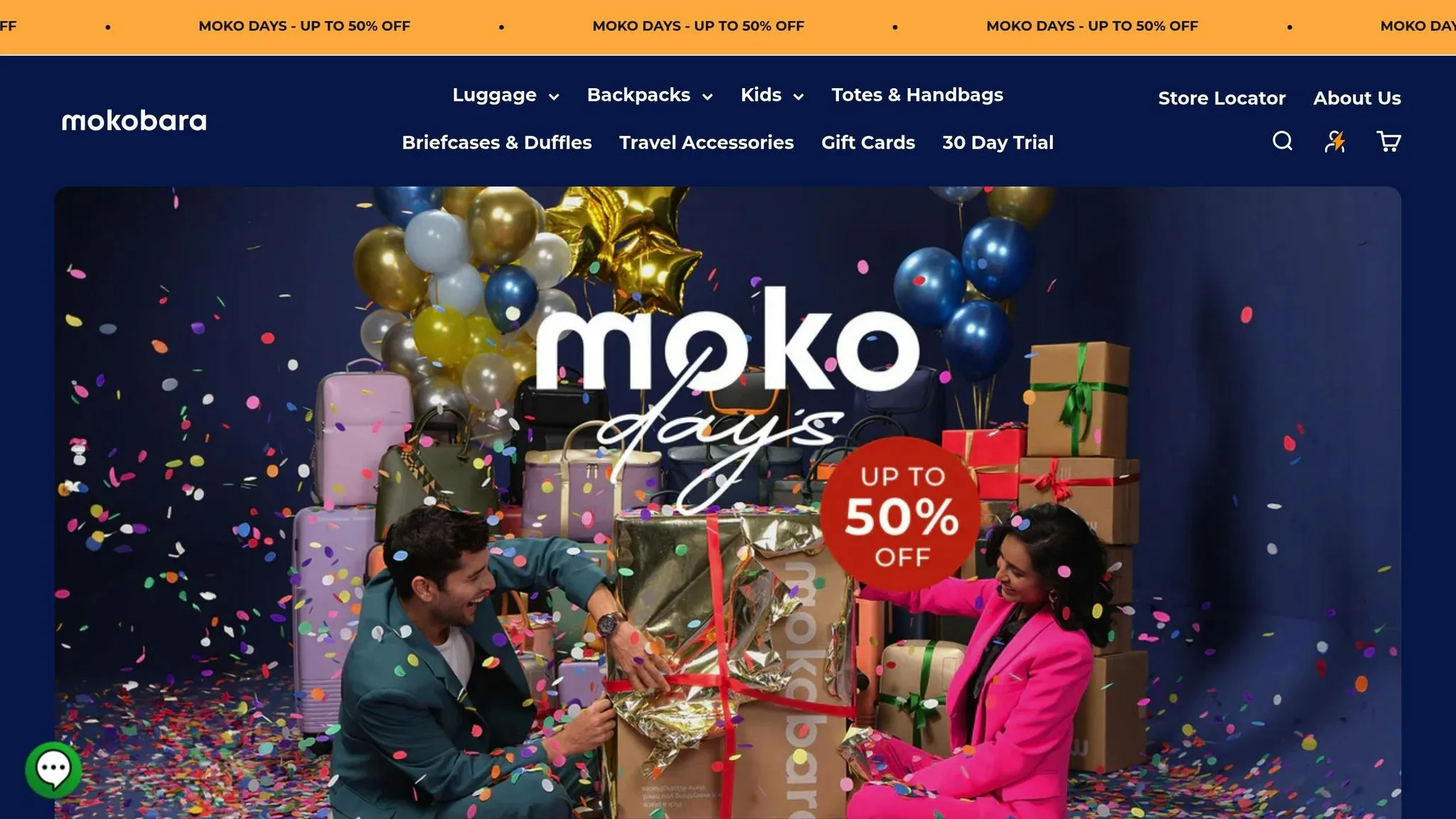
Mokobara, much like trailblazers in beauty and eyewear, has carved a niche by blending inventive design with a powerful digital presence to shake up the traditional luggage market. What started as a fledgling venture has now blossomed into a leading name in travel lifestyle, transforming luggage from a mere utility into a bold fashion statement. By targeting the mass-premium segment, Mokobara has captured the attention of urban millennials who value stylish, design-driven products.
Impressive Revenue Growth in Recent Years
Mokobara’s financial journey has been nothing short of impressive. In FY24, the brand’s revenue soared to ₹117.44 crore - a dramatic 120% increase from ₹53.27 crore the previous year - while its losses were cut in half, dropping from ₹8.22 crore to ₹4.24 crore. By the end of 2024, the company had grown its team to 179 employees, reflecting its expanding operations and growing footprint. Currently, Mokobara ships over 35,000 units monthly, with lifestyle accessories contributing 45% of sales and luggage making up the remaining 55%.
Funding Milestones and Investor Support
With $22.1 million raised across multiple funding rounds, Mokobara has secured strong backing from investors. A significant turning point came in February 2024 when the brand raised $12 million in a Series B round led by Peak XV Partners, with participation from Sauce VC and Saama Capital. This funding round valued the company at $80 million post-money and set the stage for ambitious plans, including retail and global expansion, such as opening stores in the UAE.
Unique Product Features and Design Philosophy
Mokobara’s approach to design is inspired by the Swedish concept of “Lagom”, which emphasises balance and functionality. As co-founder Sangeet Agrawal explains:
“We never called ourselves a luggage company. We’re a travel fashion and lifestyle brand”.
The brand sets itself apart with thoughtful product features aimed at solving common travel woes. For instance, Mokobara uses Hinomoto wheels from Japan to ensure smooth mobility. Its suitcases are built with reinforced hard shells for durability while maintaining a sleek appearance, and every product features the brand’s signature yellow lining. Additional touches like integrated USB ports, laundry bags, magic erasers, and straps for children’s luggage enhance the user experience. A collaboration with IndiGo airlines led to the Moko 6E Luggage collection, which comes in IndiGo’s signature blue and offers travellers an extra 2kg baggage allowance.
Co-founder Navin Parwal adds:
“We want our customers to experience joy when they open our bags”.
Digital Strategy and Social Media Success
Mokobara’s digital strategy is all about selling the feeling of travel, rather than simply highlighting product features. The #GoingPlaces campaign resonates deeply with urban millennials, turning customers into enthusiastic ambassadors for the brand. On Instagram, Mokobara blends polished visuals with user-generated content, influencer collaborations, and celebrity endorsements to create a vibrant digital presence.
Navin Parwal explains the brand’s focused approach:
“The temptation when using digital marketing for a new brand is to focus on features and keep experimenting with new positionings. We were careful not to do either. Our content was always focused on the joy of travel and we kept up the drumbeat of this positioning”.
Strategic partnerships have amplified Mokobara’s reach. The Indigo 6E collaboration introduced a co-branded luggage line with added baggage perks, while a partnership with Blinkit positioned Mokobara as one of the first luggage brands featured on a quick-commerce platform. Through Blinkit, customers can shop for travel essentials like fanny packs, slings, and neck pillows. These initiatives highlight Mokobara’s ability to innovate in a space traditionally focused on product features, contributing to its impressive 120% year-over-year growth rate.
7. Bewakoof
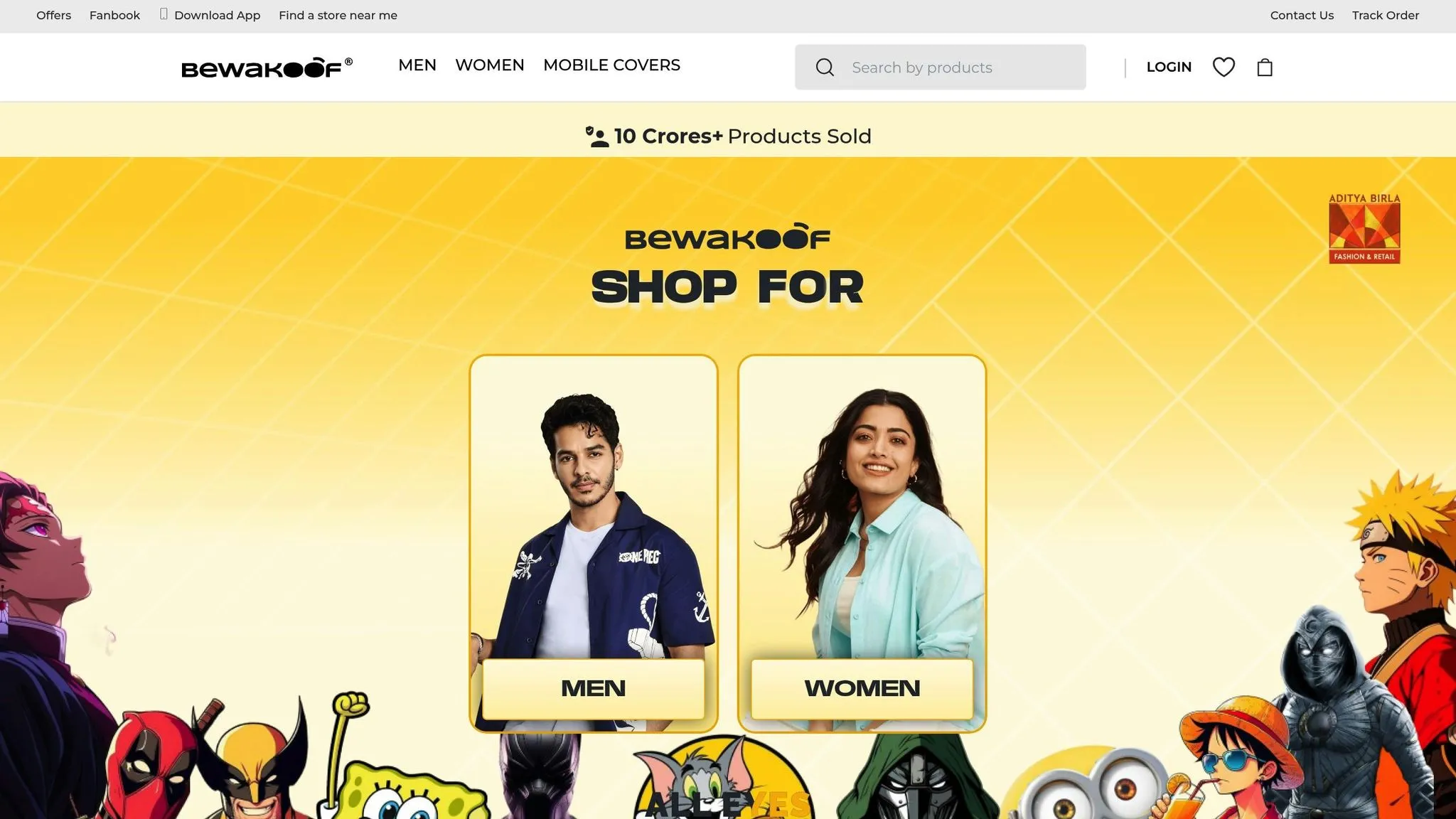
Bewakoof has grown from a quirky t-shirt startup into India’s largest D2C fashion brand, now catering to over 6 million customers across 90 countries and achieving a turnover of more than ₹100 crore. This transformation is evident in its expanding reach, strong financial performance, and impressive digital presence.
Rapid Revenue Growth in Recent Years
In FY22, Bewakoof reported combined revenue of over ₹157 crore, and its upward trajectory continued into 2024. By March, the brand was adding 1 lakh new customers every month and delivering to 19,000 PIN codes. The momentum gained an extra push after its acquisition by TMRW in November 2022.
Prabhkiran Singh, Founder and CEO of Bewakoof, credits this success to the brand’s ability to adapt and diversify:
“Bewakoof has emerged as the largest D2C fashion brand in India, this growth has come on the back of rolling out new categories, exclusive fashion range with brands like Coca Cola.”
A Strong Digital Game and Social Media Impact
Bewakoof’s digital strategy revolves around creating engaging and relatable content. With over 40.1 lakh followers on Facebook and 2.39 lakh on Instagram, the brand connects with its core audience - primarily aged 18–34 - through humour, memes, and pop culture. On YouTube, its data-driven marketing approach, including the use of YouTube Shopping Cards to retarget past customers, has delivered a 4× return on ad spend and resulted in over 8,000 conversions.
The brand’s moment marketing tactics, like celebratory posts when RCB wins a match, and partnerships with celebrities such as Sanya Malhotra, further enhance its relatable and vibrant brand identity.
Expanding Categories and Unique Product Offerings
Starting as a quirky t-shirt brand for college students, Bewakoof has evolved by tapping into cultural trends to make its designs stand out. Its t-shirts often feature Bollywood dialogues, nostalgic cartoon references, and trending memes, making each product more than just apparel - it’s a statement.
“Their designs were not just prints; they were a statement - whether it was a funny take on student life, a nostalgic reference to old cartoons, or a trending meme, every t-shirt had a story to tell.”
Beyond t-shirts, the brand now offers joggers, shorts, dresses, mobile accessories, and footwear for men and women. It’s also branching into new categories like activewear and innerwear, while scaling up its beauty brand, Cosmos. By using insights from social media and crowdsourced ideas, Bewakoof frequently introduces limited edition collections and collaborates with influencers and films. Every product and campaign reflects the brand’s youthful and witty persona, keeping it fresh and relevant to its audience.
8. The Souled Store
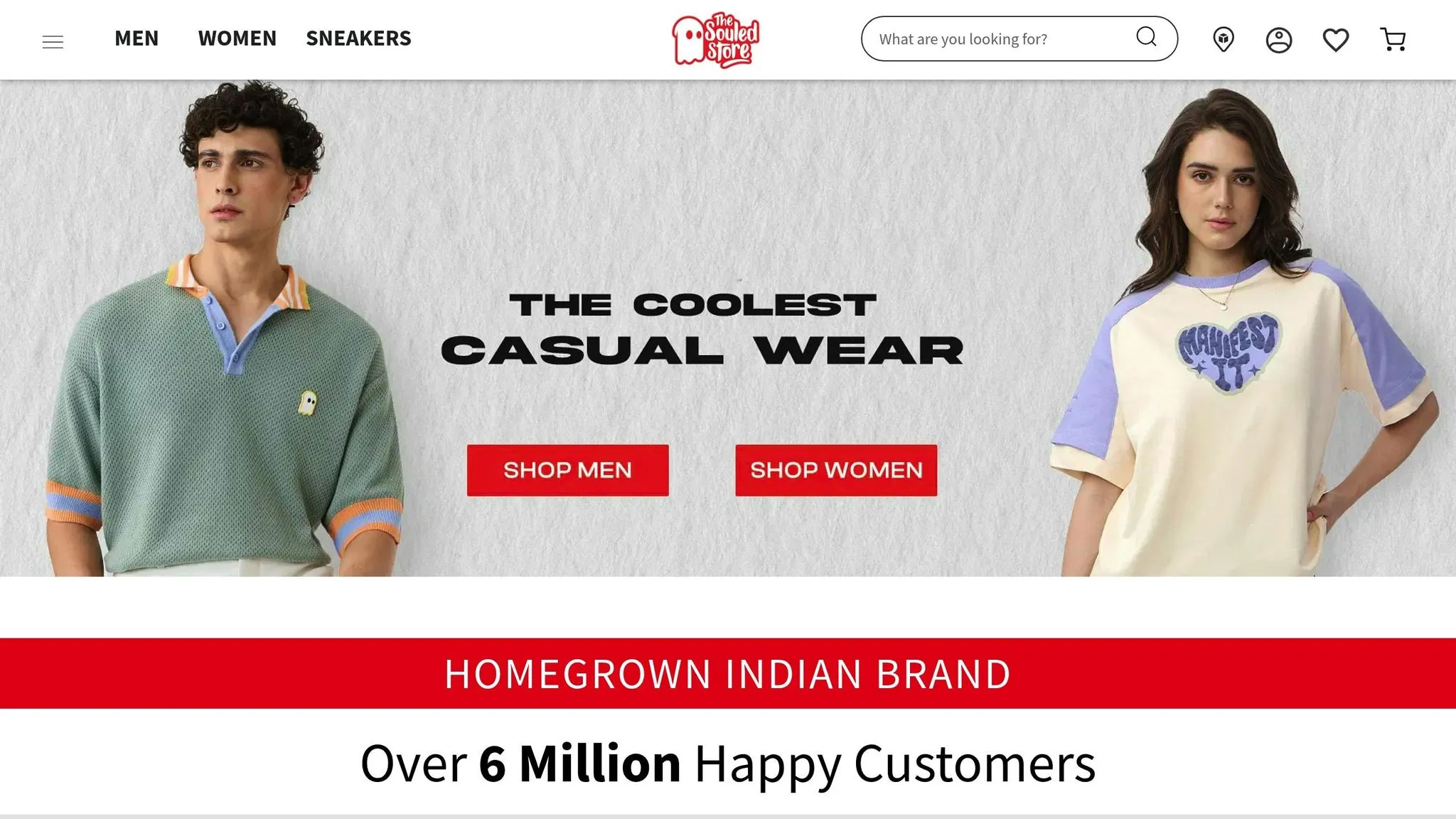
The Souled Store stands out as one of India’s leading D2C brands, combining pop culture with commerce in a way that resonates deeply with its audience. Known for its tagline, “Follow your soul,” the brand has carved a niche by offering licensed merchandise from popular franchises, TV shows, superheroes, music, and sports. This unique focus has not only shaped its identity but also driven its impressive financial growth and digital success.
Impressive Revenue Growth in FY24
The Souled Store achieved remarkable financial milestones in FY24, reporting a 54.5% year-on-year revenue increase, reaching ₹360 crore. Of this, ₹355 crore came from retail and online product sales, marking a 55% growth in this segment. The company also turned profitable, recording a net profit of ₹18 crore, a significant turnaround from the ₹16.5 crore loss in FY23.
With a customer base of over 8 million registered users, the brand ships between 15,000 and 20,000 orders daily. Notably, its D2C channels account for 64% of its total revenue.
A Digital Strategy That Delivers
The Souled Store’s digital-first approach has been a key driver of its success. By blending pop culture themes with fashion-forward designs, the brand creates content that resonates with its audience. As co-founder Rohin Samtaney puts it:
“We want to be known as a brand that mixes pop culture and fashion seamlessly in their products. We’re also slowly building a stronger content strategy as well where we have more of a voice on pop culture topics such as films, TV shows, cartoons, etc.”
The brand allocates over 90% of its marketing budget to platforms like Facebook, Instagram, Google, and YouTube. This strategy has paid off, with its Instagram page averaging 4.5k likes and 14k video views, achieving a 0.60% engagement rate. Additionally, 42.78% of its website traffic comes from organic Google searches, with organic search traffic reaching 835.13K compared to 41.27K from paid sources. Mobile users dominate the website traffic, accounting for 88.49% of visits as of March 2024. The brand also uses techniques like moment marketing, contests, AR games, and discounts to drive engagement and sales.
Licensed Merchandise and Product Innovation
What sets The Souled Store apart is its focus on licensed merchandise, ensuring authenticity in a market often flooded with generic designs. With over 150 licenses, the brand offers official merchandise from major franchises. Co-founder Vedang Patel highlights their mission:
“We are building the home of pop culture. If there’s any new TV show or movie coming, the license has to be on The Souled Store production.”
Initially known for its graphic t-shirts, which still account for nearly 50% of sales, the brand has expanded its portfolio to include hoodies, joggers, shirts, and accessories. Their pricing strategy ensures affordability, with t-shirts ranging from ₹300 to ₹800 and joggers priced between ₹500 and ₹1,200.
The Souled Store leverages technology to reduce lead times, enabling quick launches of products tied to trending movies, TV shows, or events. By focusing on Indian content and collaborating with local artists and celebrities, the brand has fostered a loyal community of over 2 million customers. With monthly shipments exceeding 100,000 orders, The Souled Store exemplifies the growth and creativity shaping India’s D2C landscape.
9. Rage Coffee
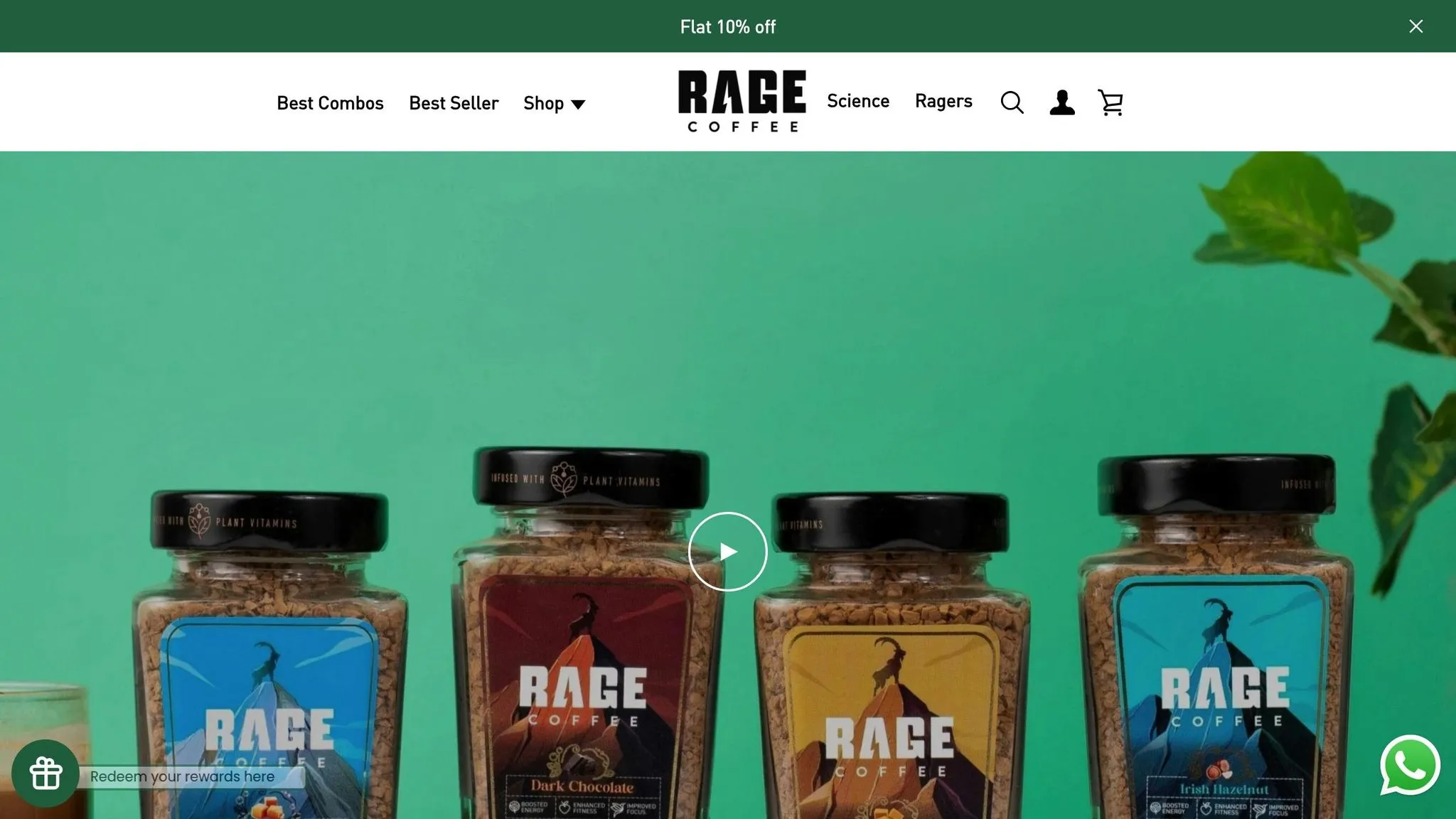
Rage Coffee, like many thriving D2C brands, has shaken up India’s coffee market by blending sharp market insights with inventive strategies. Founded by Bharat Sethi, the brand has redefined coffee consumption in India by focusing on premium instant coffee that aligns with the changing preferences of Indian consumers.
Rapid Growth Over the Last Few Years
Rage Coffee has seen impressive financial growth. Its revenue skyrocketed from ₹4.5 crore in FY22 to ₹23.5 crore - a fivefold increase. By March 2024, the company reported annual revenue of ₹25.1 crore. To support this growth, the brand established a 30,000 sq. ft manufacturing unit in Gurugram and expanded its product range to include cold coffee brew bags, frothers, snack bars, and cookies. With over 7.5 lakh customers served, Rage Coffee is now aiming for ₹500 crore in revenue by 2025.
The brand’s omnichannel strategy is a key driver of its success. Half of its sales come from online platforms, while the other half is generated through offline channels spanning more than 2,500 locations. Rage Coffee’s D2C website also demonstrates strong customer loyalty, with 35% of customers returning for repeat purchases and 70% of revenue coming from loyal buyers. This growth is further supported by a robust digital engagement plan.
A Strong Digital Footprint and Social Media Impact
Rage Coffee’s success is also rooted in its dynamic digital presence. Instagram serves as its main platform for connecting with a community of coffee enthusiasts. Founder Bharat Sethi highlights its importance:
“Instagram is where we directly engage with our community of coffee lovers, building awareness, introducing new products, and sharing our knowledge and passion for coffee.”
The brand has amplified its reach through influencer partnerships, including a collaboration with Virat Kohli. A promotional video featuring Kohli garnered over 5 million views, solidifying Rage Coffee as his preferred choice for energy and focus. Creative campaigns like the “Rage Coin” AR filter contest in July 2021 further boosted engagement. This campaign reached 397,900 unique users, with 12,263 opens and 4,751 participations. The top three winners even received a year’s supply of free coffee. Speaking about the campaign, Sethi remarked:
“The campaign aimed to foster interactive discussions on cryptocurrency and Bitcoin and pique our consumer’s interest which we have managed to do successfully.”
Filling Market Gaps with Unique Products
Rage Coffee has tapped into a market gap by focusing on premium instant coffee. As Sethi observed:
“People’s taste buds have evolved, but there was no change in the industry.”
The brand uses a proprietary crystallisation technique to preserve the beans’ natural flavour and aroma. By sourcing coffee directly from Harar in Ethiopia’s highlands, Rage Coffee offers a product that resonates with India’s growing love for coffee.
Sethi credits the brand’s achievements to a combination of data-driven decision-making and innovative manufacturing:
“Being a digitally native d2c brand we have been able to make data-backed decisions. That combined with innovative manufacturing practices has led to the success of the brand.”
This approach aligns seamlessly with India’s third wave coffee movement, as coffee consumption in the country reached over 1,180 thousand 60-kg bags in FY2021.
10. Epigamia
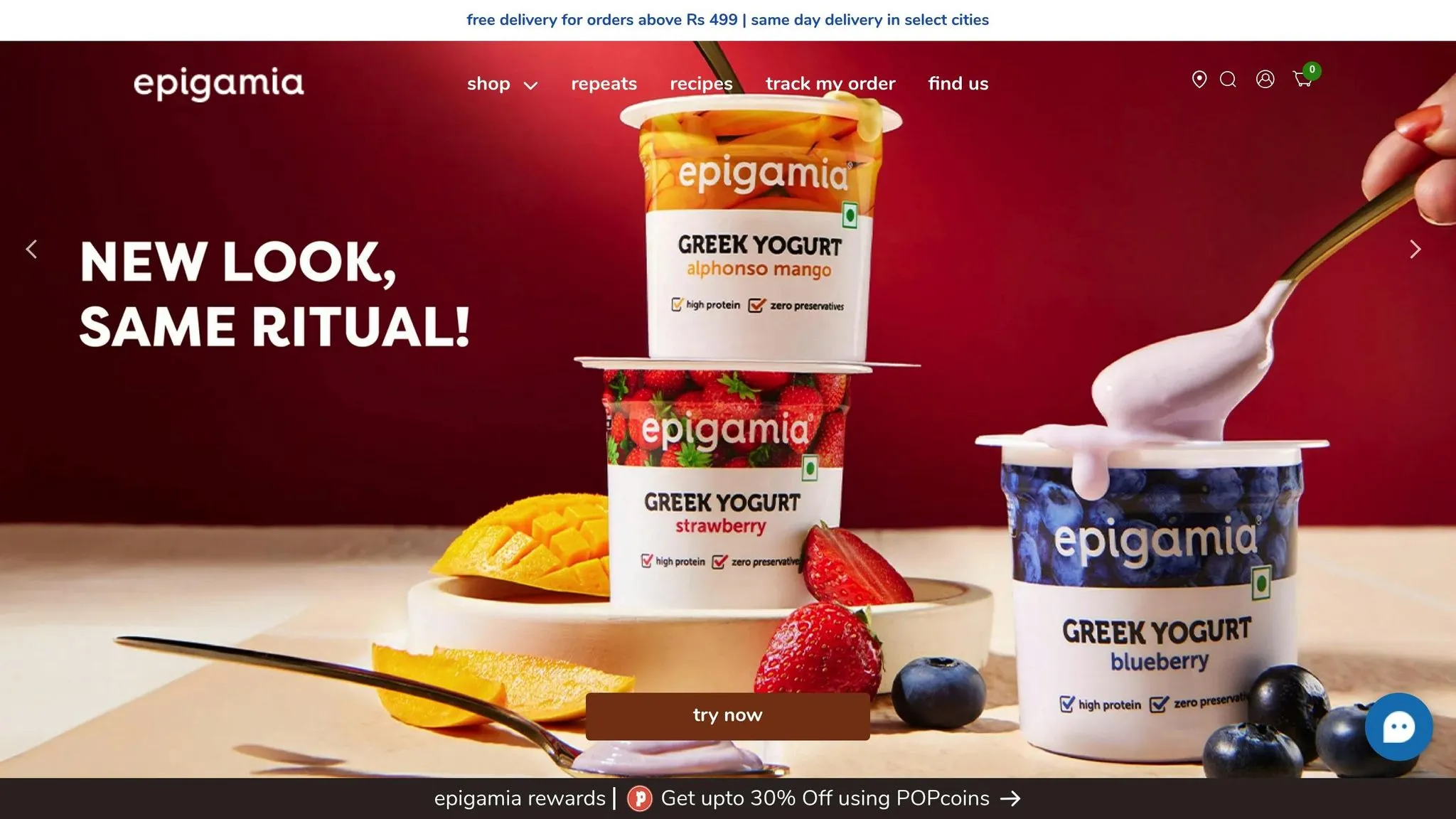
Epigamia has carved out a unique space in India’s dairy market by introducing Greek yogurt to the masses, setting a benchmark for how D2C brands can transform traditional industries. With a focus on fresh food innovation and cold chain distribution, the brand has turned everyday dairy products into healthy, convenient snack options tailored for modern Indian lifestyles.
Rapid Revenue Growth in Recent Years
Epigamia has seen impressive growth over the past few years. In FY23, the company reported revenue of ₹172 crore and is targeting ₹250 crore by FY25. Quick commerce channels contribute nearly 47–48% of this revenue, while high-protein products make up 12%. The brand’s reach is equally noteworthy, with its products now available in over 25,000 outlets across India’s top 30 cities. This strong performance has been a driving force behind its aggressive funding efforts.
Strategic Funding and Investor Support
Epigamia’s growth has been backed by strategic investments amounting to $81.4 million across 18 funding rounds. This includes a $25.7 million Series C round led by Verlinvest and a ₹182 crore investment from Danone Manifesto Ventures. Prominent investors include Verlinvest, Fireside Ventures, and Shripad Nadkarni. Bollywood actress Deepika Padukone also joined the list of backers through her firm KA Enterprises in March 2019.
In June 2020, the company secured an additional ₹40 crore from Danone Manifesto Ventures and Mousse Partners. More recently, it raised ₹35 crore through debt funding from Grand Anicut in 2022. These funds have been pivotal in expanding Epigamia’s product offerings and scaling its operations.
Innovative Products and Market Differentiation
With the support of substantial funding, Epigamia has built a diverse, preservative-free product portfolio featuring 36 SKUs. These include Greek yogurts, smoothies, milkshakes, curd, and plant-based alternatives. Region-specific flavours like mango chilli and masala chaas have helped the brand make inroads into Tier-2 and Tier-3 cities. One of its latest innovations, Greek Yogurt + Oats & Seed Mix sweetened with honey and dates, caters to the growing demand for clean-label, on-the-go snacks.
Isha Dhoble, VP of Marketing & Strategy, explained how Epigamia stands out in the market:
“When we started off, we were sure that we wanted to stay away from conventional codes of the dairy industry, which was communicated through our packaging and the way we were communicating with our customers. That has helped us differentiate ourselves from the traditional dairy market and create a niche for ourselves”.
The brand’s move into plant-based options has further broadened its appeal, addressing the needs of vegan and lactose-intolerant consumers. At the same time, its preservative-free formulations resonate with health-conscious buyers who prioritise clean-label products.
11. SleepyCat
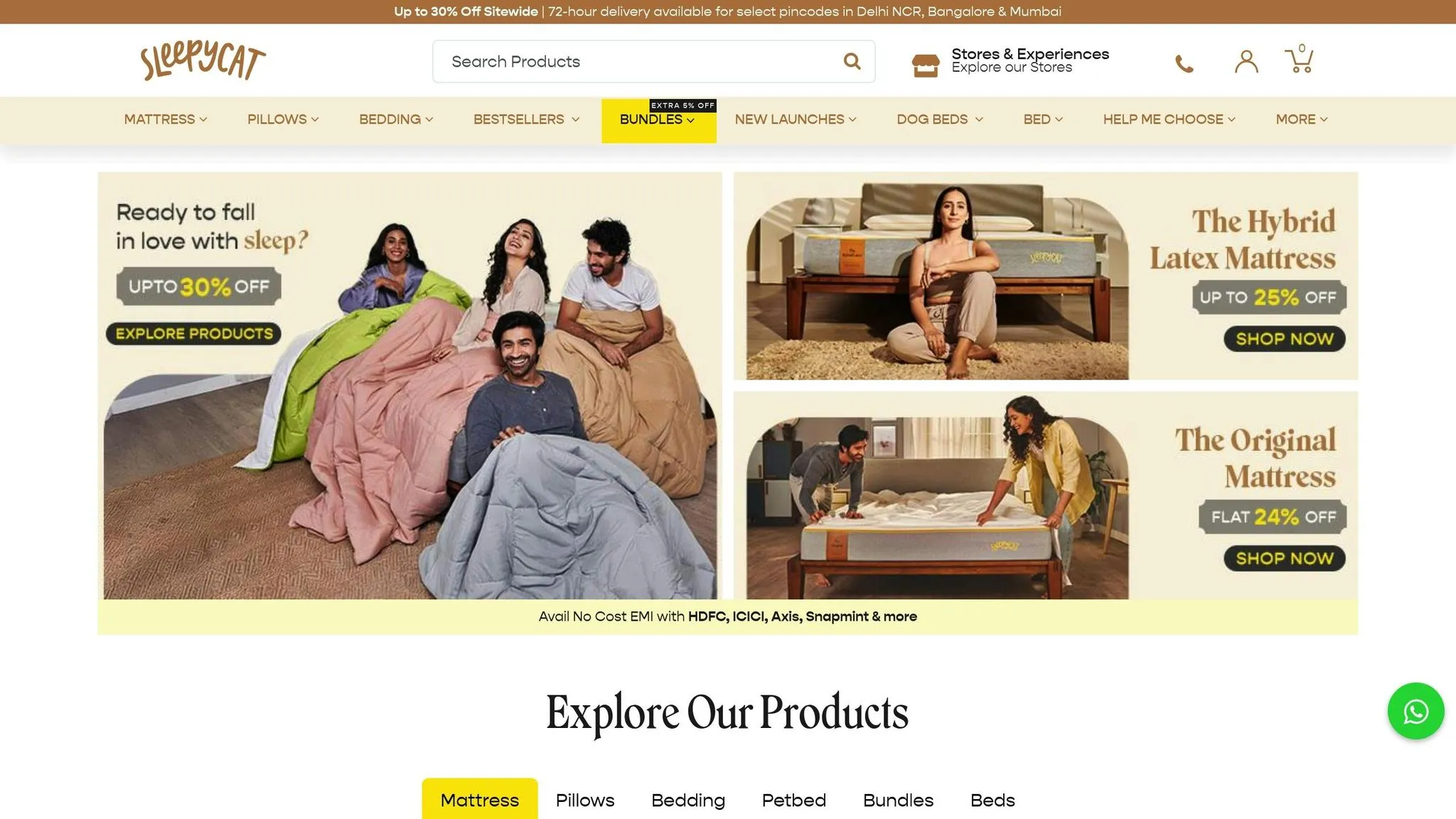
SleepyCat has shaken up India’s mattress industry with its innovative ‘mattress-in-a-box’ concept. Founded by Kabir Siddiq in 2017, this direct-to-consumer (D2C) brand started with a single product but quickly grew into a comprehensive sleep solutions company. By combining fresh ideas with a strong customer focus, SleepyCat has managed to challenge the norms of a traditionally rigid market.
Rapid Revenue Growth in Recent Years
The company’s growth trajectory is nothing short of impressive. SleepyCat reported ₹55 crore in revenue in FY23, marking a fivefold increase over four years. This growth aligns with India’s booming mattress market, which was valued at $1.7 billion in 2018 and projected to reach $2.5 billion by 2022.
Currently, SleepyCat ships around 10,000 products every month and has catered to more than 3 lakh customers. In 2023, the brand expanded its offerings beyond mattresses, launching over 10 new products like pillows, bedsheets, and comforters. This diversification has been a key driver of its growth. Speaking about the company’s progress, founder and CEO Kabir Siddiq emphasised:
“We will also galvanize research and development for product innovation.”
Product Differentiation and Market Leadership
What sets SleepyCat apart is its ability to combine affordability and luxury. The brand’s direct-to-consumer model eliminates middlemen, ensuring consistent quality and competitive pricing. Their product line includes orthopedic mattresses with removable covers and cooling memory foam mattresses infused with temperature-regulating crystals.
SleepyCat has also grown into a full-fledged sleep solutions provider, offering items like pillows, comforters, bed bases, weighted blankets, and even pet beds. Reflecting on the journey, Kabir Siddiq shared:
“From introducing India to the concepts of ‘mattress-in-a-box’, we have grown into a complete sleep solutions brand where we not only provide mattresses but also other bedding essentials that add luxury to your sleep routine.”
The company maintains a focused product lineup, offering five types of mattresses designed to suit different sleeping styles. Siddiq added:
“We have achieved a great product-market fit that can be seen with our mattress being the highest rated in the country.”
Digital Innovation and Consumer Engagement
SleepyCat’s success isn’t just about its products - it’s also about how the brand connects with its audience. By leveraging advanced digital tools, the company has enhanced customer interactions. AI-based chatbots handle common queries, provide setup guides, and share product details. This approach, combined with active social media monitoring, has cut response times by 75%.
The brand’s website is another standout feature, offering personalised product recommendations based on factors like age, sleep habits, and specific needs. This digital-first strategy has helped SleepyCat reach over 50,000 customers.
In May 2025, SleepyCat launched a bold campaign titled “The slap in the face we all need”. Using the tagline #SleepSolvesEverything, the campaign aimed to challenge the hustle culture and highlight the importance of sleep for overall well-being. Kabir Siddiq explained the thought process behind their digital strategy:
“We use tools that help us analyse trends and data and action digital marketing campaigns accordingly. From building social media engagement activities to influencer-based marketing, we try to inculcate the importance of sleep by being a user-friendly brand.”
12. Wakefit
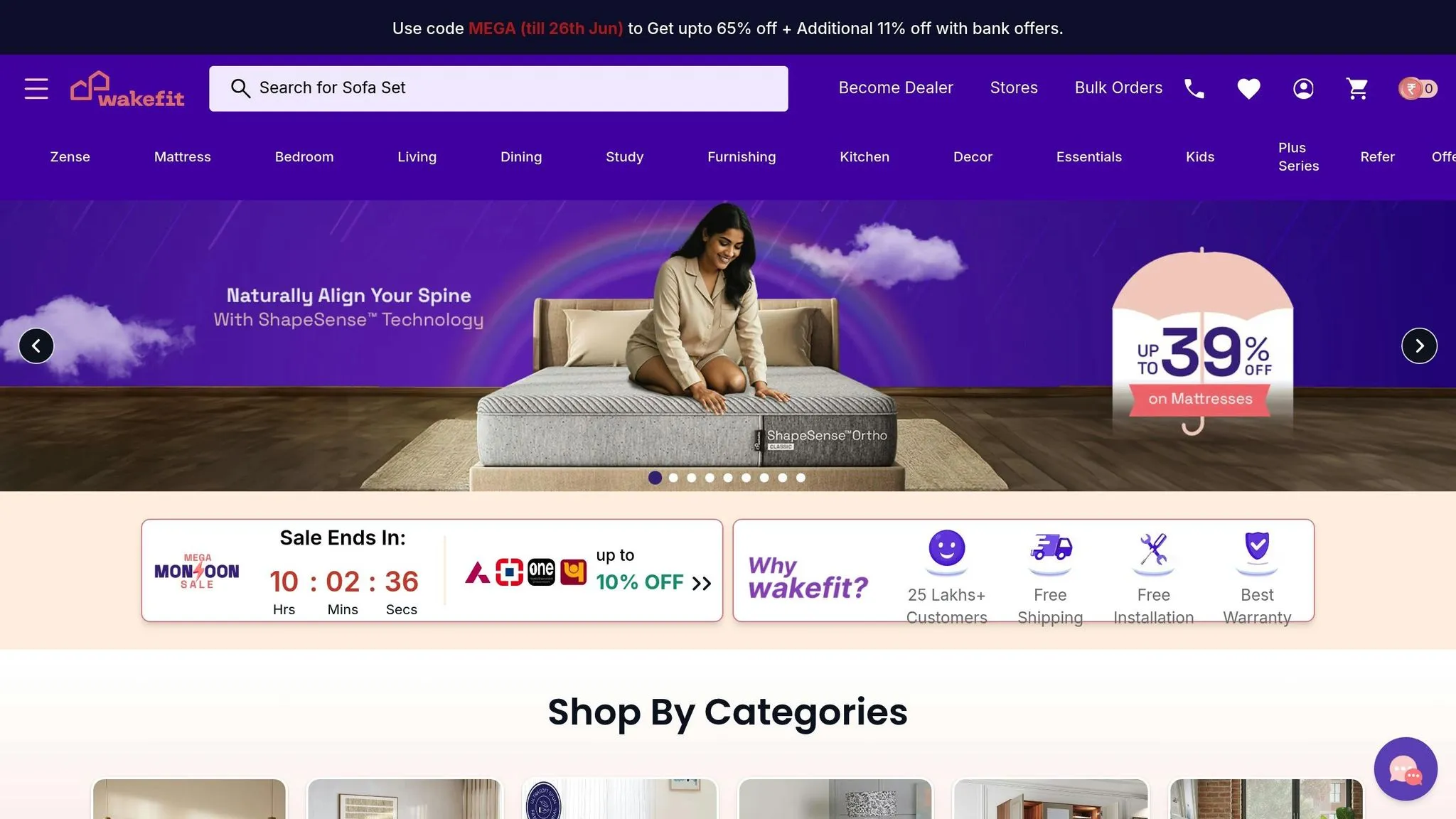
Wakefit has emerged as a standout name among India’s D2C brands, transforming from a mattress-focused startup into a leader in home furnishings. The company began with a mission to improve sleep quality across Indian households and has since built a vertically integrated model, managing everything from manufacturing to delivery. This approach has allowed Wakefit to scale quickly in the competitive home solutions market.
Impressive Financial Growth in Recent Years
Wakefit’s financial trajectory has been nothing short of remarkable. In FY24, the company achieved revenues exceeding ₹1,000 crore, reflecting a 24% year-on-year growth. Additionally, it reported ₹65 crore in EBITDA-level profitability, while dramatically reducing losses by 90%, from ₹145 crore to ₹15 crore.
Co-founder and Director Chaitanya Ramalingegowda described this milestone as a testament to customer trust:
“Crossing the INR 1000 crore revenue milestone marks a significant achievement for us and reflects the immense trust that our customers have placed in us. Our 24% year-on-year growth underscores our commitment to delivering innovative and high quality products while staying attuned to the evolving needs of Indian households.”
Meanwhile, Co-founder and CEO Ankit Garg highlighted the company’s operational discipline:
“Returning to profitability with an EBITDA of INR 65 crore is a testament to the resilience of our business model and the efficiency of our operations. This milestone reflects the disciplined financial management we have implemented while continuing to invest in areas that fuel growth.”
This strong financial performance has further bolstered investor confidence in Wakefit.
Steady Funding and Strong Investor Support
Over the years, Wakefit has raised a total of $105 million across four funding rounds, with its largest being a Series D round of $43.3 million in January 2023, led by Investcorp and Peak XV Partners. The consistent backing from Peak XV Partners, starting with its Series A round in 2018, underscores the long-term belief in Wakefit’s vision.
Expanding Product Range and Market Presence
Wakefit’s product portfolio has grown significantly, now encompassing over 100 categories and 6,000 SKUs, including home decor, lighting, and furnishings. The launch of Zense, an AI-driven sleep solutions range, marked its foray into SleepTech, further strengthening its position as a pioneer in sleep innovation.
The company also places a strong emphasis on consumer education. Brand Head Phalguni Aneja explained:
“Our vision is to improve the sleep quality in India. To that end, we have continuously innovated to ensure we bring the best-in-class sleep solutions to the market at affordable prices.”
One of its standout initiatives, the Sleep Internship programme, has garnered immense attention, with over five lakh applications for its fourth season. This highlights Wakefit’s commitment to raising awareness about sleep health.
Since branching into offline retail in 2022, Wakefit has opened over 80 stores across 26 cities, with plans to expand to 120 stores within the next eight months. This omnichannel strategy combines the convenience of online shopping with personalised in-store experiences, helping the brand connect more deeply with its customers.
CMO Kunal Dubey summed up the company’s approach:
“Consistent growth requires frequent pivots rather than resting on initial success. It’s about making pivots every 12 to 24 months.”
Wakefit’s focus on efficiency, innovation, and consumer education has not only solidified its market leadership but also led to a 40% increase in top-of-mind awareness.
13. Oziva
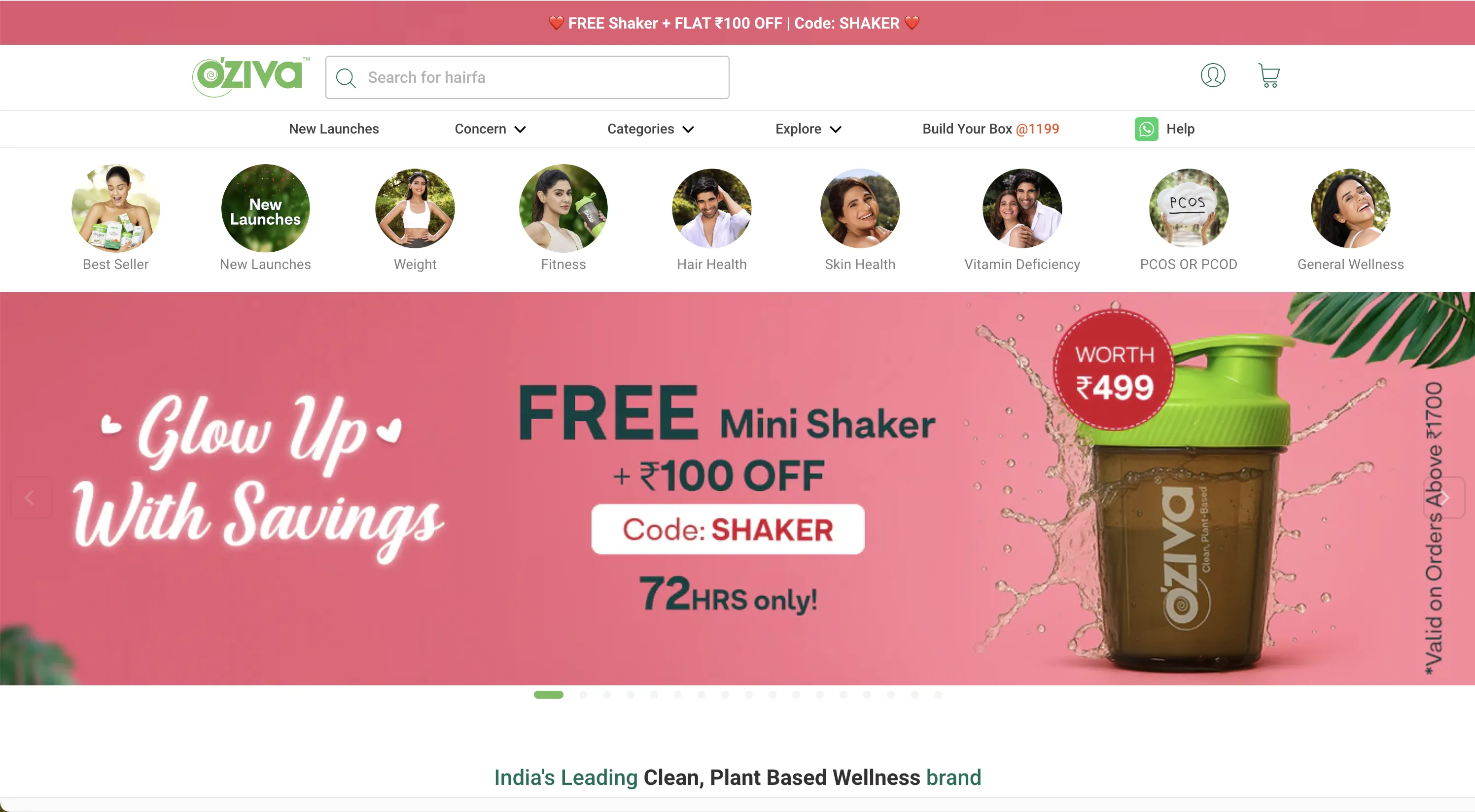
Oziva has made its mark in India’s competitive health and wellness market by offering clean, plant-based nutrition solutions. With a sharp focus on innovation and a customer-first approach, the brand has risen to prominence, going beyond the traditional supplement space.
Rapid Revenue Growth in Recent Years
Oziva’s growth trajectory took off after Hindustan Unilever Limited (HUL) acquired the brand. This partnership has been transformative, with the company scaling from ₹100 crore to ₹400 crore in annual recurring revenue (ARR) while also improving profitability. This impressive 300% revenue growth highlights the synergy between Oziva’s innovative products and HUL’s extensive distribution network and expertise in category development.
The brand’s success is deeply rooted in its holistic wellness strategy. Co-founder Aarti Gill shared insights into their approach:
“Having a strong digital ecosystem and personalised consultations has helped us in delivering more than just the product and has reflected in our growth numbers as well as unit economics. We will keep investing and creating solutions focusing around 3 pillars of fitness - nutrition, workouts & mental wellness”.
This comprehensive outlook has struck a chord with Indian consumers, especially as awareness of the benefits of clean-label nutrition grows. Investments in research and development, technology, and team expansion have further propelled Oziva’s growth.
Innovation in Products and Category Leadership
Oziva has raised the bar in the nutraceutical space with rigorous scientific testing and clinical validation, catering to over 2.5 million consumers in a country where 80% face micronutrient deficiencies.
Their commitment to innovation extends to ingredient sourcing. For instance, Oziva has filed patents for deriving calcium and iron from plant sources, showcasing their dedication to clean, plant-based solutions. This aligns with a growing preference for ingestible formulations in the beauty and wellness industry.
One standout product, Oziva Collagen Builder, underwent a clinical study where 90.6% of participants reported visibly brighter, more youthful skin within eight weeks, and nearly 70% noticed improved elasticity and hydration.
Co-founder Mihir Gadani highlighted their focus on science-backed products:
“Skin Nutrition is extremely important for overall skin health. Hence, we are thrilled to present these latest findings of our clinical study on OZiva Collagen Builder. At OZiva, our objective is to deliver science backed natural solutions for overall health and wellbeing.”.
This emphasis on clean, evidence-supported nutrition reflects a broader trend among Indian D2C brands, which are building consumer trust through innovation.
Building a Robust Digital Ecosystem
Oziva complements its product innovation with a strong digital presence. Their strategy revolves around personalised consultations and fostering a sense of community. The brand’s OZiva Prime membership offers unlimited access to nutritionists for lifestyle coaching, creating a complete wellness ecosystem rather than just selling products.
This digital-first approach has caught the attention of investors. Sanjot Malhi, Director at Matrix India, explained what sets Oziva apart:
“OZiva symbolizes the future of wellness and nutrition, with its vision to be the #1 Plant-based nutrition brand in the country. Its maniacal product focus using the highest quality ingredients, as well as leveraging the power of content and community to educate and learn from consumers makes it a truly differentiated offering.”.
Oziva’s growth coincides with a booming market. The Indian nutraceuticals market is projected to double within the next five years, and Oziva is well-positioned to ride this wave, thanks to its strong digital infrastructure and proven scalability.
14. The Whole Truth
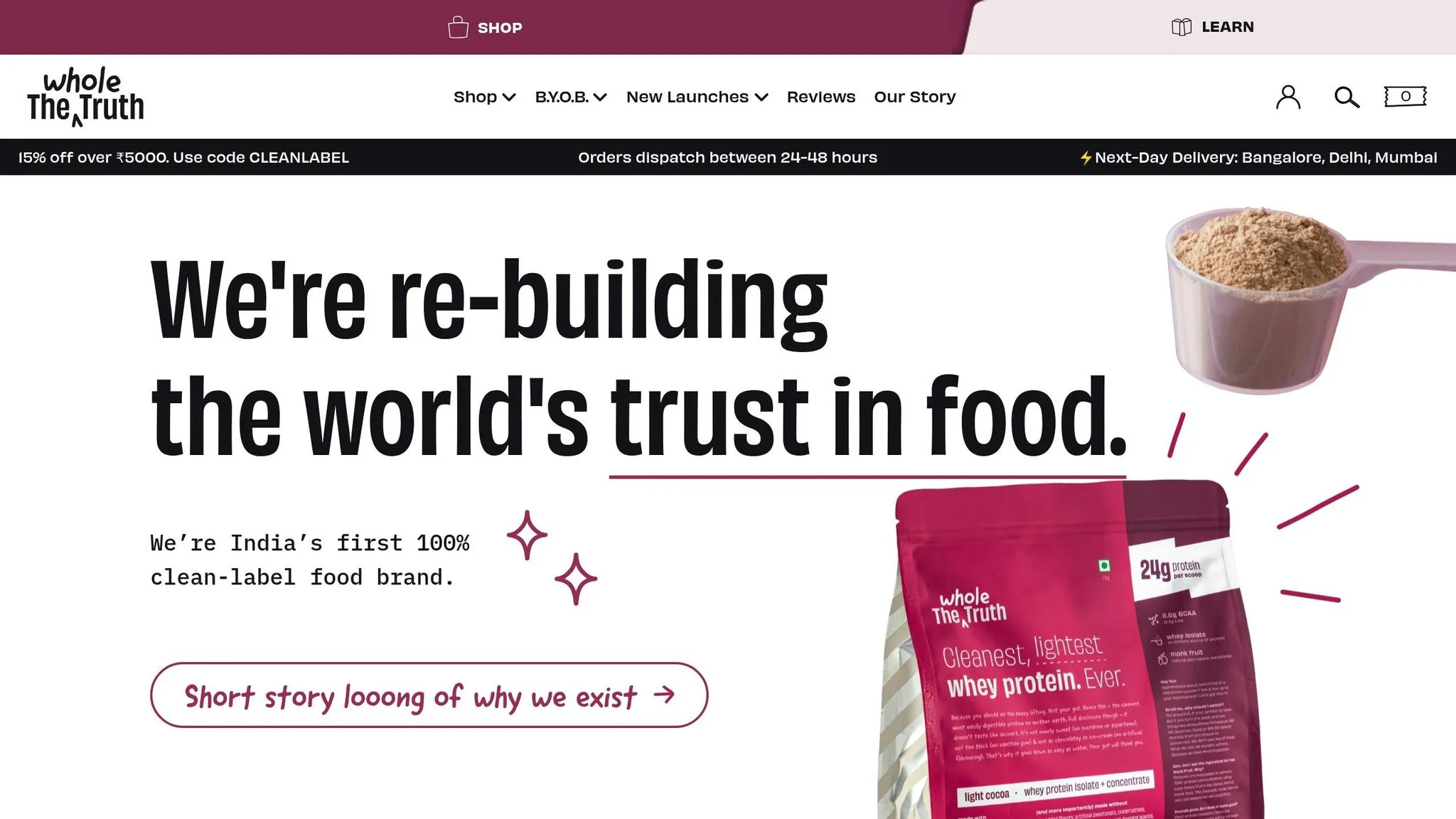
The Whole Truth has emerged as one of India’s standout clean-label food brands. Founded by Shashank Mehta, the brand is built on a foundation of ingredient transparency and a commitment to healthy snacking. Its no-frills, honest approach to clean eating has helped it carve out a strong position in the market.
Rapid Revenue Growth Over Recent Years
The numbers tell a compelling story. The Whole Truth ended FY25 with a revenue of around ₹200 crore - a staggering 200% jump from FY24. In FY23, the company had already posted a 125% rise in operating revenue, reaching ₹36 crore. Over the last three years, it has achieved an impressive 900% growth, and it currently operates at an annual revenue run rate of ₹250–300 crore. This surge is fueled by growing consumer awareness, higher disposable incomes, and the expansion of quick commerce platforms.
Manu Chandra, founder and managing partner at Sauce VC, reflected on the brand’s journey:
“When we invested in The Whole Truth in 2019, it was just an idea, and the company was pre-revenue. We believe that awareness about what people are consuming is increasing, and that awareness levels will start influencing what people consume. The way it has panned out now is beyond what we had anticipated.”
The brand’s growth aligns with the booming healthy snacking market in India, currently valued at $4 billion and forecasted to grow 3.5 times faster than traditional packaged snacks.
Key Funding Milestones and Investor Support
The Whole Truth’s financial performance has attracted significant investor interest. In February 2025, the company raised $15 million in a funding round led by Sofina. It also enjoys the backing of Peak XV Partners (formerly Sequoia Capital India). Abhishek Mohan, principal at Peak XV, remarked on the brand’s appeal:
“Impulse categories like snacks are ideally suited to the format, and healthy brands that deliver on convenience are seeing a strong lift.”
This influx of funding has allowed The Whole Truth to expand its product range and solidify its market presence. The company is now valued at ₹2,000 crore.
Differentiation Through Transparency and Strategy
Armed with solid financial backing, The Whole Truth has sharpened its product strategy. The brand’s commitment to transparency and clean ingredients sets it apart. Founder Shashank Mehta explained his unique approach:
“If they use sexy models, we will use an un-sexy founder. If they put food porn on the pack, we will not put any photo. If they make tall claims with star marks, we won’t make any claim at all. If they hide ingredients in a microscopic font at the back, we will declare them in a big bold font upfront.”
This philosophy has struck a chord with consumers, especially in India’s top 8–10 cities. Mehta further elaborated:
“All the brands (in this space) are premium brands and that’s largely because input costs for good ingredients are higher. It’s still largely a top 8–10 cities phenomenon.”
Initially, the brand focused on niche products like protein bars and peanut butter. Over time, it has expanded into more competitive categories, a move that has significantly contributed to its growth.
Leveraging Digital Channels and Social Media
The Whole Truth’s success isn’t just about its products - it’s also about how it connects with consumers. Around 80% of its sales come from online platforms, thanks to a well-executed digital strategy. The brand uses long-form content on YouTube to spark conversations about health, fitness, and clean eating. It has also created a “Truth Seekers Community” on WhatsApp, fostering discussions around fitness, health, and food.
In February 2025, the brand made waves with a campaign featuring comedian Rohan Joshi, which humorously critiqued misleading claims by other “protein shake” brands. Shashank Mehta himself appears in these campaigns, using self-aware humour and radical transparency to make a lasting impression.
The Whole Truth’s website goes beyond being just an e-commerce platform. It serves as a hub for information on nutrition and health, reinforcing the company’s mission to educate consumers about clean eating and ingredient honesty. By blending transparency, digital engagement, and a strong brand identity, The Whole Truth continues to strengthen its foothold in India’s growing healthy snacking market.
15. boAt
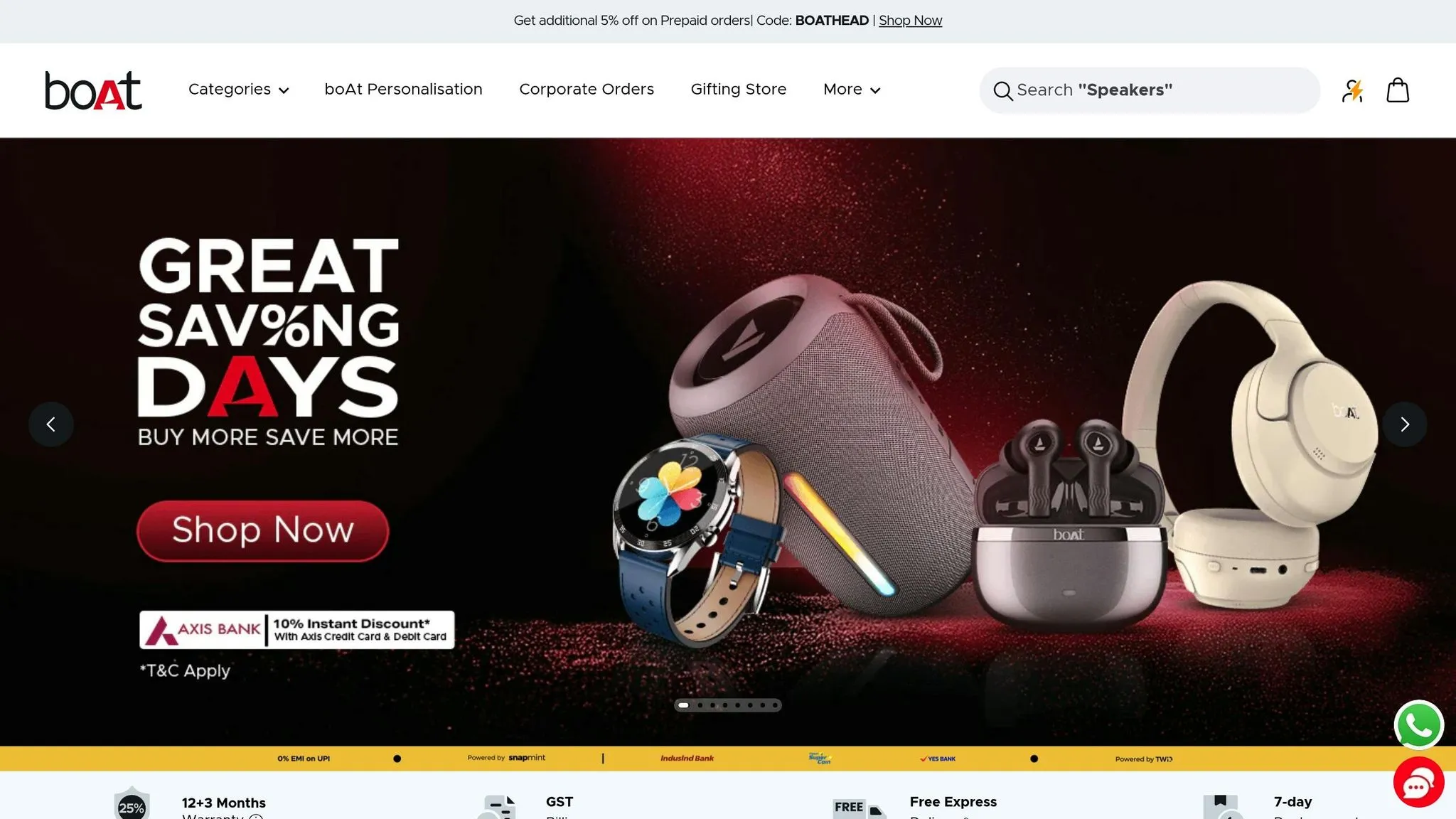
boAt has established itself as a prominent Indian audio brand, offering affordable yet stylish products that strongly appeal to younger audiences. This connection with its target demographic has translated into impressive financial results.
Rapid Growth and Market Leadership
Despite challenges in the market, boAt has demonstrated consistent revenue growth. In FY24, the company reported an operating revenue of ₹2,459.2 crore, marking a 5% increase from FY23. In 2023, boAt captured a 26% share in the TWS (True Wireless Stereo) category and held an overall market share of 29.7% in India, with annual revenue exceeding US$424 million.
Aman Gupta, the company’s CMO, emphasised the importance of staying ahead in a dynamic industry:
“Once a startup reaches a certain level of success, it becomes necessary to invest in R&D and be on your toes as the industry changes very fast”.
Affordable Products with a Stylish Twist
boAt’s success stems from its ability to combine affordability with style, making it a favourite among millennials and Gen Z. The brand’s product strategy focuses on sleek designs, regular updates, and functional features like long battery life, water resistance, and superior sound quality.
Special collections, such as the Marvel-themed line inspired by superheroes and the boAt x Masaba Gupta collaboration, further highlight its focus on unique and trendy designs. Vivek Gambhir, boAt’s Chief Executive, explained their approach to catering to a diverse audience:
“We are experimenting with a multi-brand approach; there is a significant opportunity to straddle the entire price pyramid”.
Building a Strong Digital and Social Media Presence
boAt’s innovative product strategies are matched by its strong digital presence. The brand excels in creating engaging content, leveraging influencer marketing, and running targeted advertising campaigns. It actively uses platforms like its mobile app, email, SMS, and social media to connect with its audience. Campaigns like the #boatheads initiative and interactive Instagram stories have helped cultivate a loyal community.
Influencer collaborations have played a key role in boosting boAt’s visibility, with a 44% rise in celebrity endorsements. Partnerships with IPL teams, Bollywood stars, and cricket personalities have further elevated the brand. boAt even collaborated with KYRA, India’s first meta influencer, for the #futureofaudio campaign to promote its rocker range. By December 2020, boAt had become the fifth-largest wearables brand globally, showcasing the strength of its digital-first approach. With an average Flipkart price of ₹1,199, boAt ensures its products remain accessible to a broad audience.
Profitability Challenges
While boAt has excelled in growth and market share, profitability remains a challenge. The company’s gross margin is around 22%, significantly lower than the 35–40% margins achieved by global competitors like JBL and Skullcandy. Striking a balance between competitive pricing and sustainable margins will be key as boAt continues to innovate and expand its footprint.
16. Noise
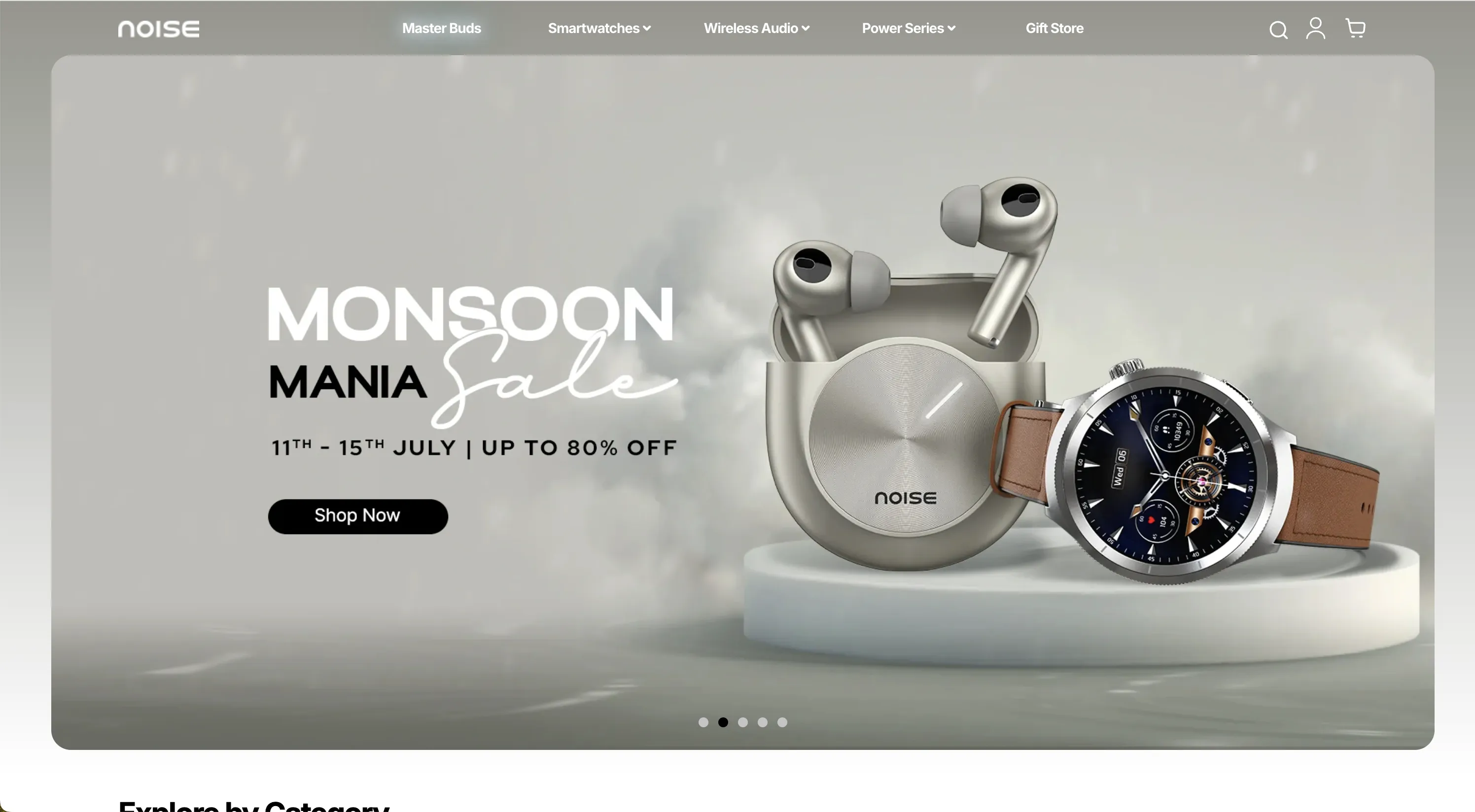
Noise has become a major player in India’s wearables market, transforming from a startup into the world’s third-largest smartwatch maker. Its success lies in offering affordable, feature-rich products that appeal to a broad audience.
Rapid Revenue Growth in Recent Years
In just a few years, Noise has shown impressive financial growth. The company reported a 79.8% rise in revenue in FY23, reaching ₹1,426 crore, up from ₹793 crore in FY22. By FY24, revenues stabilised at ₹1,431 crore. Wearables made up nearly 80% of the brand’s sales in FY24, with audio products contributing 19.7%. Back in 2020, Noise was selling four products every minute, capturing 27% of the market share.
Co-founder Gaurav Khatri shared insights into the company’s growth strategy and vision for the future:
“We have been profitable for 10 years and we know the formula of how to do it. Now, it’s time to take a leap of faith and create a brand which is ready to explode outside India”.
This financial success has laid the groundwork for Noise’s expanding digital presence and market influence.
Strong Digital Presence and Social Media Strategy
Noise has embraced a digital-first approach, which has been key to its market dominance. The company maintains an 80:20 online-to-offline sales ratio, helping it achieve a 29% market share in Q1 2025. Its digital marketing efforts include social media advertising, influencer collaborations, and brand ambassador campaigns. Gaurav Khatri explained:
“Our marketing strategy encompasses a mix of digital and traditional channels, including social media advertising, influencer partnerships, and more. Using brand ambassadors has deepened customer engagement. While performance marketing continues to be a top priority, we are also expanding into new channels like affiliate marketing and quick commerce, with encouraging outcomes”.
Noise actively interacts with its audience through platforms like social media and community forums, allowing it to keep pace with market trends and consumer preferences. This digital engagement has also helped the brand fine-tune its product offerings to align with customer needs.
Expanding Categories and Product Differentiation
Noise has made advanced wearable technology accessible by focusing on affordability, stylish designs, and practical features. Its products cater to health, fitness, and lifestyle needs, helping the brand build a strong connection with its audience. The NoiseFit App, for instance, now serves over 9 million users, fostering a sense of community around wellness and fitness.
The company’s commitment to technology and consumer engagement has helped it maintain a 27.4% share of India’s smartwatch market for nearly 20 consecutive quarters. Investments in in-house manufacturing and proprietary technology have allowed Noise to maintain quality while keeping prices competitive.
Reflecting on the early days, Gaurav Khatri shared:
“When Amit and I started the company, the idea was to give an international brand experience in the domestic market which you don’t get easily unless you are buying a global brand. We wanted to create a high-quality product at a price-point which Indians are used to, rather than expensive global brands”.
Looking ahead, Noise plans to expand its retail presence to 6,000 general trade stores by the end of 2025. Its entry into the GCC market highlights its ambition to grow into a global “Made in India” brand.
17. Phool
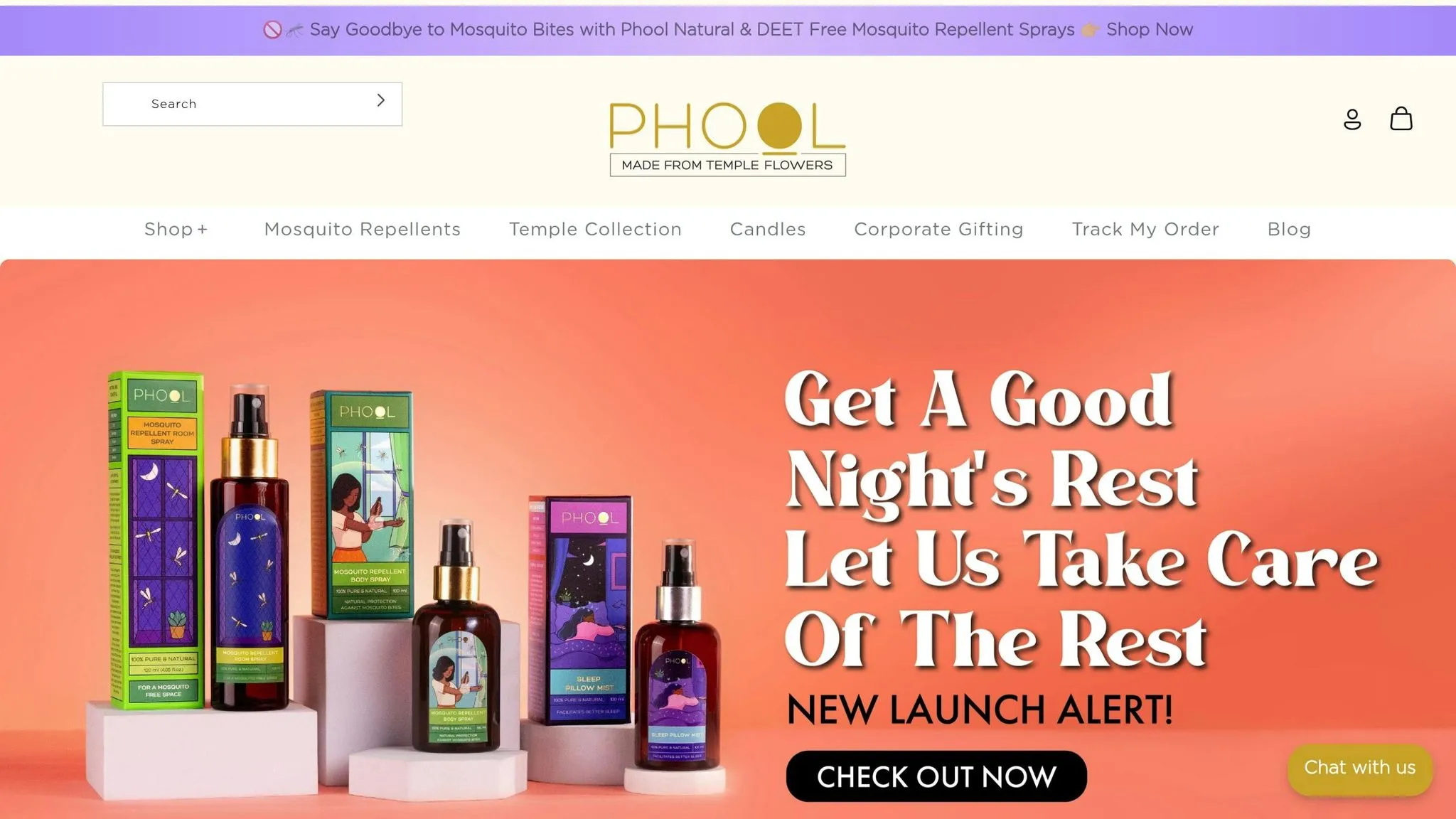
Phool takes an innovative approach to repurpose temple flower waste, turning it into eco-friendly products that are not only sustainable but also market-ready. With this unique model, the company has seen impressive growth in both revenue and operations.
Rapid Growth in Revenue Over the Last Few Years
Phool’s creative business model has translated into significant financial success. By 31 March 2024, the company achieved a revenue milestone of ₹50 crore (approximately US$15 million), with an annual growth rate of 130%. Every day, Phool diverts more than 4 tonnes of floral waste from the Ganges, and to date, it has recycled over 11,000 metric tonnes of waste.
Key Funding Milestones and Investor Support
The company has attracted substantial investor interest, raising US$12.7 million across nine funding rounds. Among its prominent backers are Sixth Sense Ventures, Alia Bhatt, IAN Fund, Draper Richards Kaplan Foundation, and IIT Kanpur. In April 2022, Phool secured US$8 million in Series A funding led by Sixth Sense Ventures, with contributions from Alia Bhatt and IAN Fund.
Alia Bhatt, who is both an investor and a brand ambassador for Phool, shared her enthusiasm for its mission:
“I believe Phool will be an important global aromatherapy story to emerge from India. And the company’s plant-based leather will also be a more humane choice for the world’s top luxury brands. As a Phool customer and as an investor, I’m putting my money where my belief is.”
Strong Digital Strategy and Social Media Presence
Phool’s digital-first approach has played a crucial role in amplifying its reach. As India’s first natural incense brand to embrace this strategy, it effectively uses social media, SEO, and trend-driven content to connect with eco-conscious, urban consumers. Its campaigns often highlight cultural events and social causes. For instance, the #PhoolWaliHoli campaign promoted its Natural Gulaal line, made entirely from flower extracts, encouraging chemical-free Holi celebrations.
Expanding Product Categories with a Focus on Sustainability
Phool has redefined the incense industry by transforming it into a lifestyle experience. Its diverse offerings include eco-incense sticks, mosquito repellents, incense cones, essential oils, soaps, organic vermicompost, and Fleather™ - a vegan leather alternative. The brand also prioritises sustainability in packaging, using seed paper embedded with Tulsi seeds and vegetable dyes. Another notable innovation is Florafoam, a sustainable replacement for plastic-based materials. These efforts have earned Phool certifications such as Fair for Life-Fairtrade and Ecocert Organic & Natural.
Founder Ankit Agarwal summarised the company’s mission:
“Phool.co is a sustainable solution to the monumental temple-waste problem in India. Through our efforts, we aim to build natural alternatives to synthetic chemical-based products by using deep-tech and research.”
Social Impact and Market Disruption
Phool’s operations go beyond sustainability; they also have a strong social impact. The company employs over 300 marginalised women and has significantly improved the livelihoods of 73 manual scavenger families, increasing their incomes by at least six times. With its innovative model, Phool is making waves in India’s direct-to-consumer (D2C) market. It aims to capture a share of the US$23 billion home fragrance market while also targeting the US$550 billion leather goods industry with its Fleather™ product.
18. Minimalist
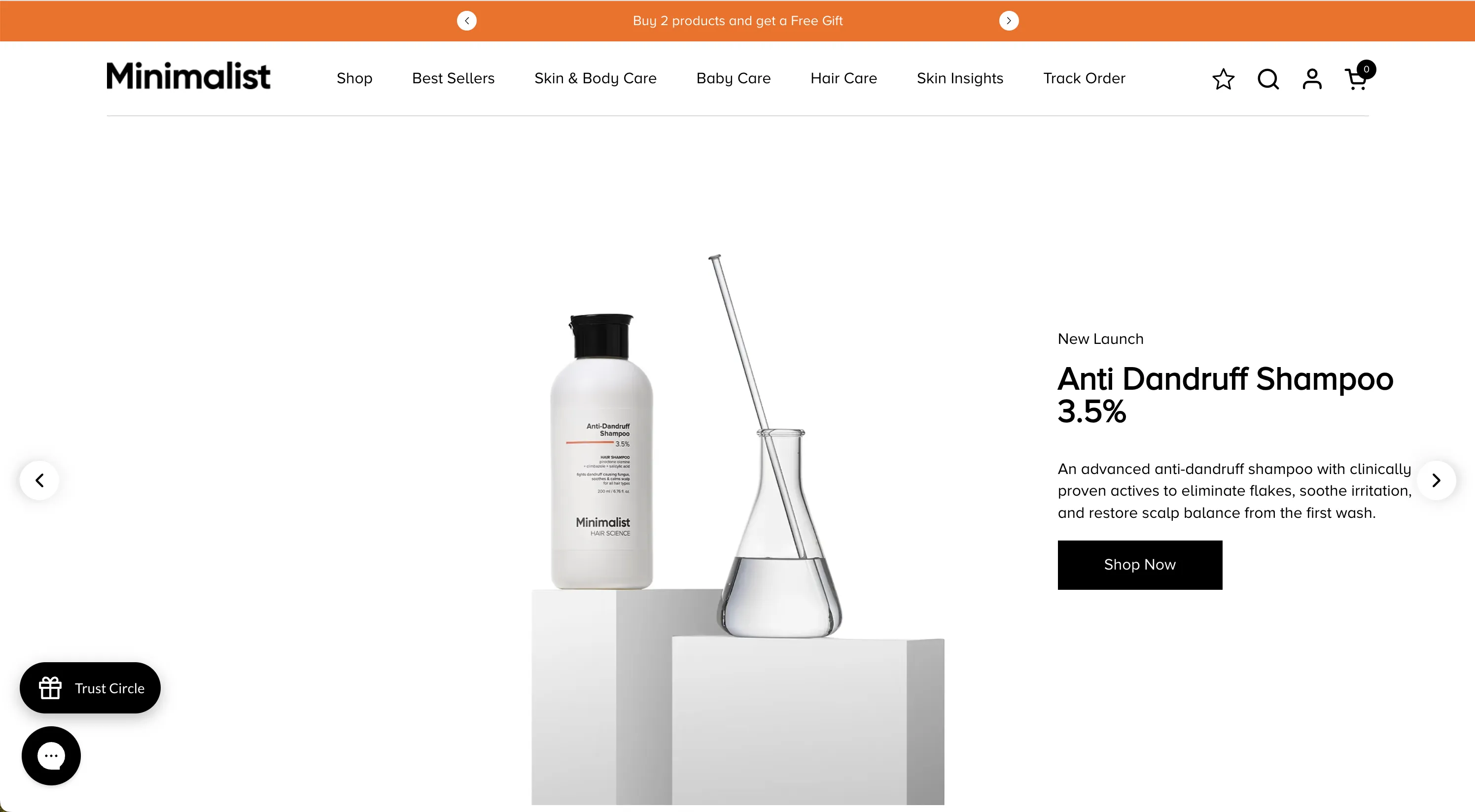
Minimalist has reshaped India’s skincare landscape with a focus on ingredient transparency and clear product labelling. By prioritising honest communication about product efficacy and safety, the brand has struck a chord with Indian consumers who value knowing exactly what goes into their skincare products.
Rapid Growth Over the Past Few Years
Minimalist’s growth trajectory has been nothing short of impressive. From zero revenue in FY21, the brand surged to ₹2.5 billion by FY24. In FY24 alone, it generated ₹350 crore in revenue, captured a 25% share of the serum market, and achieved ₹100 crore in sales within just eight months. This remarkable growth has been supported by an equally strong digital engagement strategy.
A Strong Digital Footprint and Social Media Engagement
Minimalist’s digital strategy revolves around educating consumers about the science behind skincare. Instead of merely promoting products, the brand uses platforms like Instagram and Facebook to share insights into ingredients and formulations. Campaigns like #KnowYourIngredients and #CleanBeautyMovement focus on empowering users with knowledge about skincare science.
Co-founder Mohit Yadav attributes their success to organic growth, saying:
“I think one of the reasons why we’ve grown so fast is because our initial customers spread the word about us. Word of mouth continues to get us new customers even today.”
Initially, the brand allocated 30% of its budget to marketing, but it has since pivoted to performance marketing strategies that focus on measurable outcomes. Collaborations with dermatologists and beauty influencers who provide honest product reviews have further strengthened its credibility.
Product Innovation and Competitive Positioning
Minimalist has built its reputation by offering clear, science-driven formulations at competitive prices. The brand lists active ingredients and their concentrations directly on its packaging, reinforcing its commitment to transparency. Its formulations, validated through clinical testing, include ingredients like retinal, Vitamin K, matmarine, and fullerene - many of which were not widely available in India before.
One standout product is the 18% hair growth serum, which combines Capixyl, Redensyl, Procapil, Anagain, and Baicapil to deliver results comparable to minoxidil, but without the side effects. This dedication to quality has paid off: Minimalist boasts a 65% repeat purchase rate, with 83% of users reporting noticeable improvements in their skin within four to six weeks.
The brand has also expanded its offerings to include body care, hair care, lip care, and baby care, launching over 50 SKUs in just four years. Its pricing strategy further sets it apart, with products ranging from ₹279 to ₹1,899. Many of its core products are priced between ₹300 and ₹700, making premium skincare accessible to a wide audience. At ₹599, Minimalist has successfully reached over 15,000 pin codes across India.
Co-founders Mohit Yadav and Rahul Yadav shared their vision:
“We founded Minimalist to introduce a transparent Indian beauty range that is trusted and loved on a global scale. We are grateful for the support we have received in India.”
With a 60% customer retention rate, Minimalist has cultivated strong loyalty. This high repeat purchase behaviour demonstrates that its ingredient-focused approach is more than just a marketing strategy - it’s delivering results that keep customers coming back.
19. mCaffeine
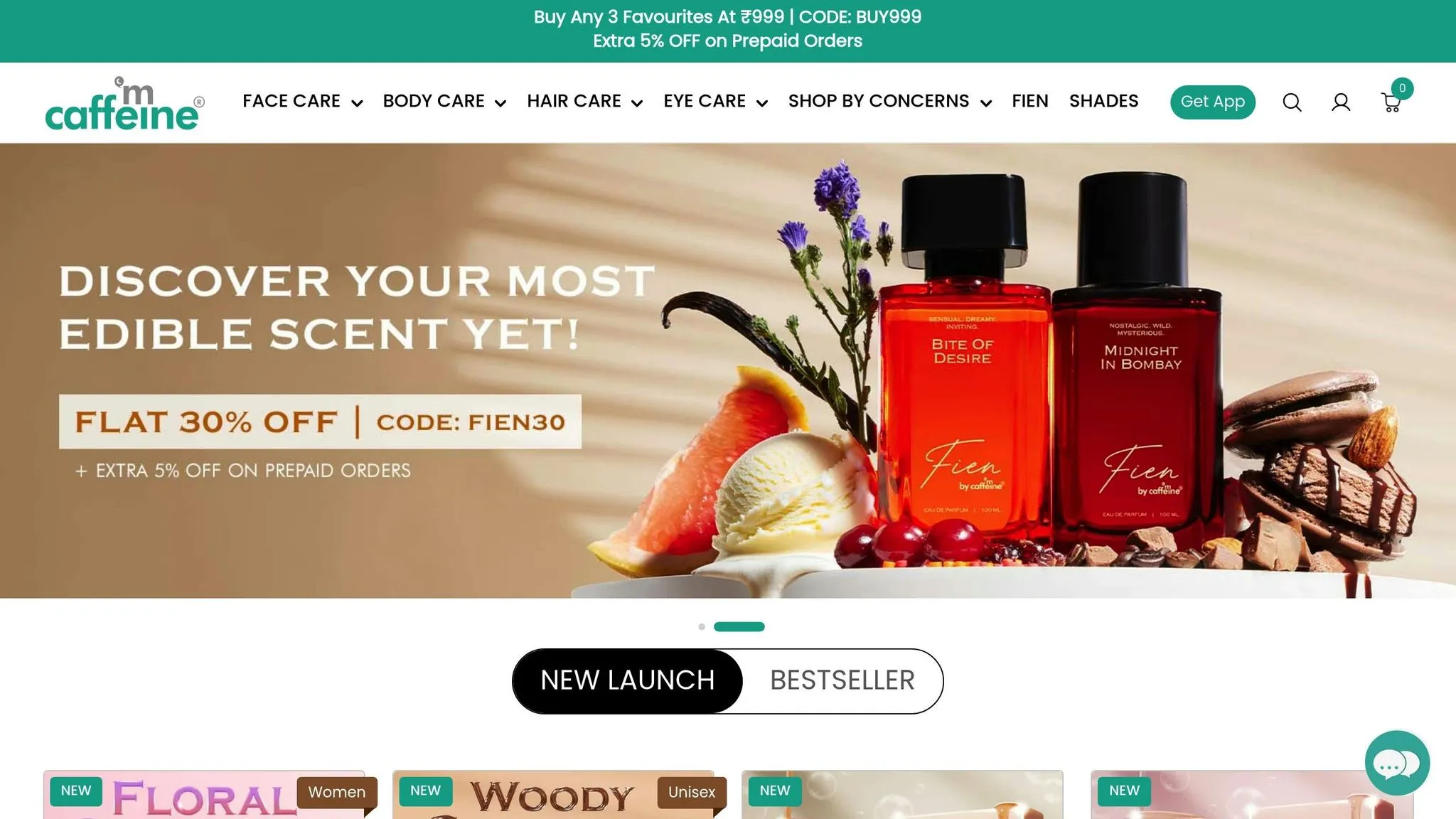
mCaffeine has carved a niche for itself in India’s beauty and personal care market with its caffeine-infused skincare, haircare, and body care products. Since its inception in 2015, the brand has sold over 10 million products, commanding an impressive 65% share of the body care market in India. Its growth reflects the bold strategies often seen in India’s booming D2C sector.
Rapid Revenue Growth in Recent Years
From ₹40 crore in FY20 to ₹205.3 crore in FY23, mCaffeine’s revenue grew fivefold. However, FY24 brought slight challenges, with revenue dipping to ₹193 crore.
A major factor behind this growth has been aggressive marketing. In FY23, advertising expenses rose by 74%, reaching ₹126.5 crore. In July 2024, mCaffeine joined hands with GoKwik, aiming to enhance its D2C operations. This partnership is expected to drive a 70% revenue increase and boost market share by 10% in key categories. Vaishali Gupta, Co-founder and Chief Growth Officer, shared her optimism about this collaboration:
“With GoKwik’s eCommerce acumen, we are set to redefine the shopper experience in the growing D2C landscape. With their solutions like KwikCheckout, we are already seeing a positive upward movement in our conversions, and overall revenue growth. We are positive this partnership will further help us in establishing a deeper, and lasting footprint across India, and compliment the next phase of our growth.”
A strong online strategy has played a crucial role in sustaining this momentum.
Building a Strong Digital Presence
mCaffeine has built a vibrant digital footprint, boasting 457k followers on Instagram and generating 20–30 daily mentions across social media platforms. Its website, mcaffeine.com, recorded 1.48 million visits in April 2024, with 93.77% of the traffic coming from mobile devices.
The brand’s creative campaigns have also driven engagement. For example, a mystery hunt in February 2023 attracted 12,000 submissions, with 20% of participants making purchases on launch day and 65% revisiting the site within 30 days.
Celebrity collaborations have further amplified mCaffeine’s reach. A campaign with Bollywood actress Alia Bhatt included the launch of a limited-edition “Alia loves mCaffeine” box, which sold out within days. The #mCaffeineSquad initiative also created a community of loyal customers, encouraging them to share their experiences on social media.
Product Innovation and Differentiation
mCaffeine’s success stems from its caffeine-focused product line, which sets it apart in the market. Co-founder and CEO Tarun Sharma explained the brand’s guiding principles:
“We keep the 3Cs in mind. We listen to our consumers, build the right categories, and expand channels for easy access. We learnt it when building mCaffeine from scratch and distilled our learning into these core principles. They have taught us how to deliver top-notch products backed by flawless execution.”
The brand also incorporates the Three Es - Ethos, Efficacy, and Experience - into its product development process. This ensures its offerings not only highlight caffeine’s benefits but also align with values like sustainability and community focus. mCaffeine’s commitment to natural ingredients, cruelty-free practices, and vegan formulations is evident in initiatives like its 2022 zero-plastic footprint campaign, launched alongside Alia Bhatt for the Coffee Body Wash and Scrub range.
Vaishali Gupta further emphasised the brand’s experiential approach:
“We are an experiential brand that delivers experiences via the texture, fragrance and design of the product. We strongly indicate experience via all of our campaigns along with the functional benefits.”
This strategic focus on innovation and customer experience has cemented mCaffeine’s position in the market. The brand has been backed by over $40 million in funding.
20. Bombay Shaving Company
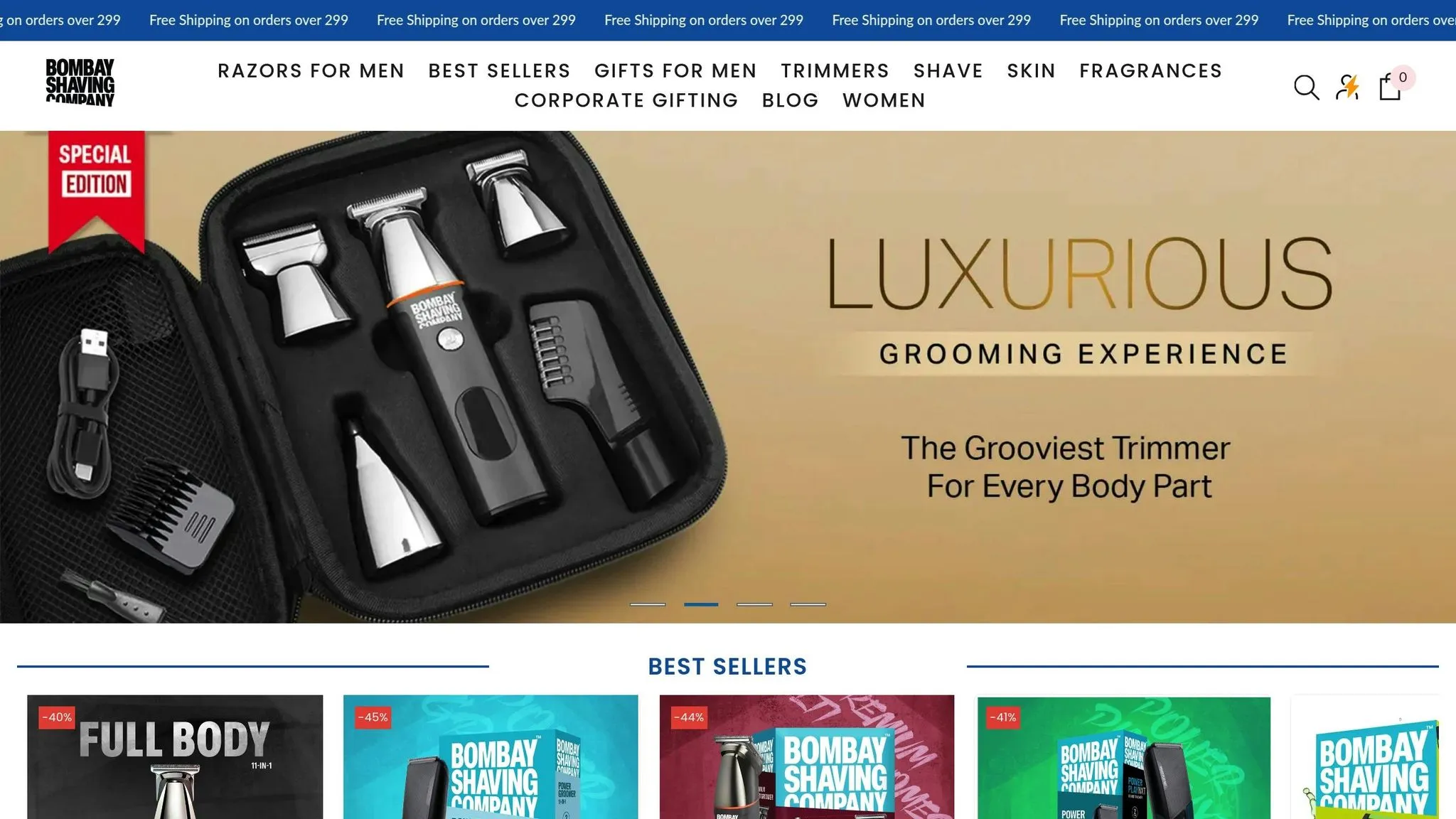
Bombay Shaving Company (BSC) has transformed from a single-product startup into a major player in the grooming industry, thanks to its digital-first approach. Founded to challenge legacy grooming brands, BSC has created a personal care ecosystem that resonates with modern Indian consumers.
Fast Revenue Growth in Recent Years
By 2025, BSC had achieved ₹300 crore in revenue and is now aiming for ₹500 crore in annual recurring revenue by FY26. This growth aligns with the expanding male grooming market in India, which is projected to hit $4.1 billion by 2032, growing at a 7.2% compound annual rate. The company operates through an omnichannel model, with about 70% of its sales coming from online platforms and 30% from offline stores. Having already served nearly 25 million customers, the brand has set its sights on reaching 100 million in the next three years.
A significant contributor to this growth is Bombae, a women’s hair removal and personal care brand launched in late 2020. Bombae now accounts for 25% of BSC’s business. Co-founder Deepak Gupta shared insights into the brand’s appeal:
“We saw a clear shift in the Indian consumer - particularly among the 16 to 30 age group - who no longer wanted to use the same brands their fathers or grandfathers did. Today’s consumers want brands they can engage with, relate to, and feel represented by.”
This impressive trajectory sets the stage for BSC’s upcoming investments and digital innovations.
Major Funding Rounds and Investor Support
BSC’s growth has been fueled by strategic investments totaling $59.1 million across 13 funding rounds. In January 2022, the company raised ₹160 crore (approximately $21.4M) in a Series C round led by Malabar Investments, with participation from Patni Advisors and Singularity AMC. This funding round also enabled employee and early investor exits worth ₹45 crore. The funds are being used to expand product lines, strengthen offline distribution, explore international markets, and invest in brand-building efforts.
Strategic investors like Reckitt Benckiser and Colgate Palmolive have brought more than just funding - they offer industry expertise and potential synergies in distribution. The company’s ownership structure is divided among founders (20.31%), funds (27.96%), enterprises (24.84%), and angel investors (17.02%).
| Date | Funding Amount | Round | Key Investors |
|---|---|---|---|
| January 2022 | ₹160 crore ($21.4M) | Series C | Malabar Investments, Patni Advisors, Singularity AMC |
| January 2021 | ₹45 crore | Series B | Reckitt Benckiser (lead), Colgate Palmolive |
| April 2024 | $2.88M | Venture Debt | Alteria Capital |
These funding milestones have allowed BSC to strengthen its digital presence and expand its product categories.
Strong Digital Presence and Social Media Engagement
BSC has built a strong digital presence, engaging its growing customer base across platforms. The brand boasts 124K Instagram followers, 47K Facebook followers, and 89.7K YouTube subscribers. Their content strategy combines education with entertainment, exemplified by “The Barbershop”, a YouTube show hosted by founder Shantanu Deshpande that features celebrity interviews and grooming discussions.
One standout campaign, the Razorpreneur Challenge in 2023, encouraged young Indians to showcase their sales skills. Top participants were featured on The Barbershop and received seed funding for their ideas. Chief Marketing Officer Gauri Malhotra explained the brand’s marketing philosophy:
“What we’re doing is turning marketing right on its head and combining two very strong ethos, which are fundamentally social first.”
Other creative campaigns include the Rishabh Pant wordplay promotion, the Tug of War campaign for Power Stretch Pants (with the “Bangalore Black” variant accounting for 60% of sales), and the Indian Pant Liberation campaign, which featured stilt walkers during a marquee match day.
Expanding Categories and Product Differentiation
BSC continues to strengthen its market position by diversifying its offerings. The brand now includes razors, skincare, body care, and even apparel through The Pant Project. Meanwhile, Bombae caters specifically to women’s grooming needs. BSC sets itself apart with premium products, eye-catching packaging, and personalised services like free name engraving on metal razors. Formulations enriched with natural ingredients like turmeric, coconut extracts, and honey have also appealed to a broader audience, shifting gifting habits - women now make up 50% of buyers, up from 27% before Bombae’s launch.
Reflecting on the impact of digital transformation, founder Shantanu Deshpande remarked:
“From a business perspective, Covid-19 helped us. A lot of shopping moved online. As a company, we are a lot more competitive online than offline.”
BSC’s omnichannel strategy ensures a presence both online and offline. The brand is available on platforms like Amazon, Purplle, Blinkit, JioMart, and Nykaa, while also maintaining a physical presence in 1,00,000 stores nationwide. Their focus on performance marketing across platforms such as Facebook, Instagram, and Google, paired with data-driven personalised targeting, has solidified BSC’s standing in India’s grooming industry.
21. Bluestone
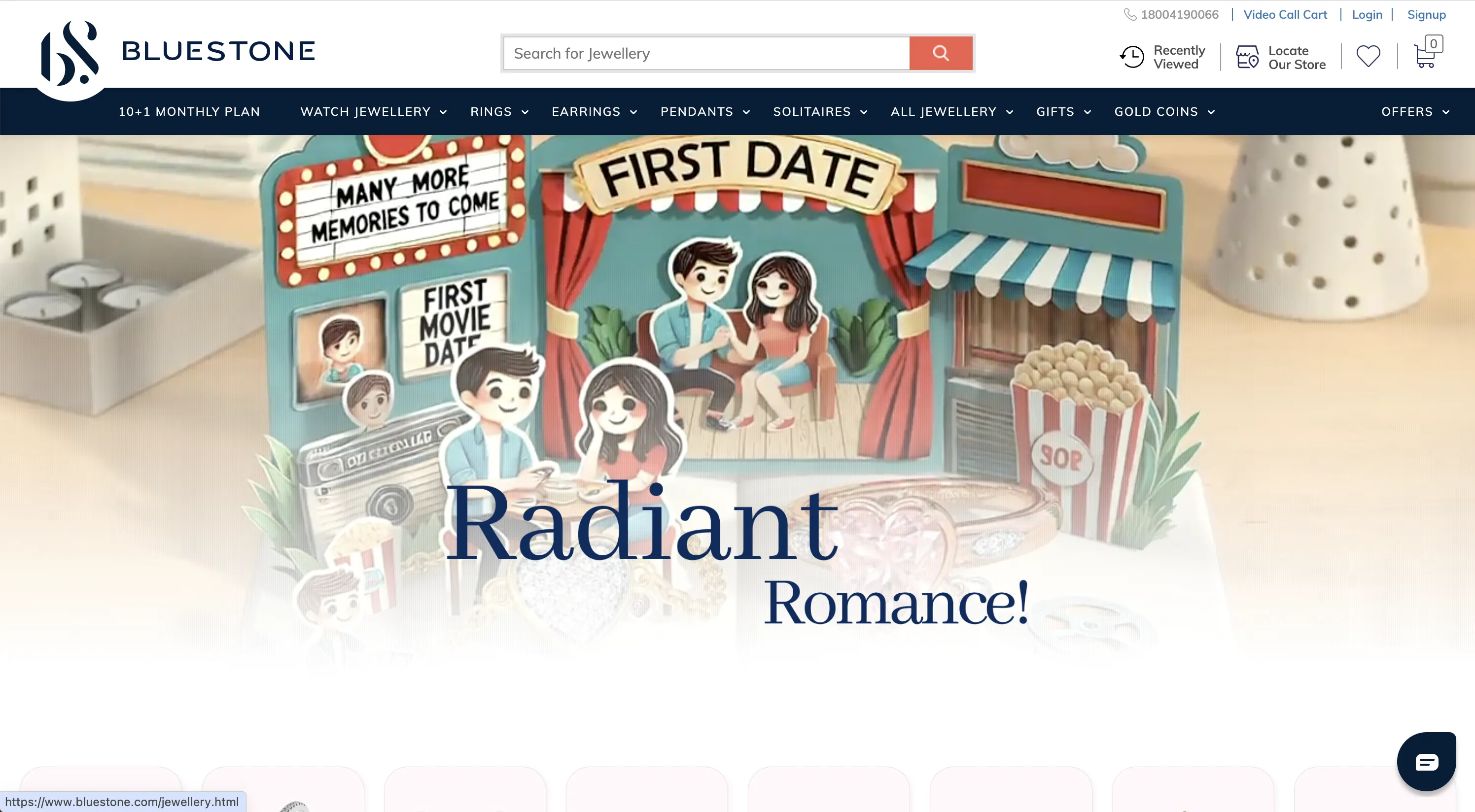
Bluestone is a rapidly growing jewellery brand in India, blending traditional jewellery shopping with the convenience of modern e-commerce. The brand has reshaped how Indians shop for jewellery, focusing on everyday wear pieces that combine style with practicality.
Impressive Revenue Growth Over Recent Years
Bluestone’s financial performance has been on an upward trajectory. The company’s operational revenue jumped by 64.24%, rising from ₹770.73 crore in FY23 to ₹1,265.84 crore in FY24. Including interest income, the total revenue for FY24 reached ₹1,303.5 crore, compared to ₹787.9 crore in FY23. Notably, Bluestone recorded the highest gross margins in the industry at 40.41% for FY24, and its customer base expanded by 115.38% between FY22 and FY24. With an estimated annual revenue of $717.6 million, the company’s strong financial standing supports its forward-thinking digital and product strategies.
Digital Strategy and Social Media Success
Bluestone has crafted a digital marketing strategy that resonates with the modern Indian woman, focusing on jewellery as a fashion statement rather than just an investment. The brand actively engages its audience across social media platforms. Its Facebook page boasts 642,142 followers, its YouTube channel has garnered over 2.15 million views, and it maintains a presence on Instagram and Twitter with 1,340 and 1,597 followers, respectively.
The company uses targeted social media campaigns to connect with its audience. For instance, during the wedding season, it promoted “#Makeitperious”, while Christmas saw the launch of “#GiftThoughtfully.” Other campaigns like “#WhatToWearWhen”, “#ImperfectLove”, and “#WhiteLiesAreGood” have showcased Bluestone’s ability to create relatable and engaging content.
Innovation in Product and Retail Experience
Bluestone has positioned itself as a pioneer in blending digital convenience with offline reliability. By focusing on contemporary, everyday jewellery, the brand caters to a previously underserved market segment, estimated at 40–45% of India’s jewellery market.
With over 7,000 certified designs, Bluestone offers extensive customisation options, allowing customers to select gold purity, colour, and diamond clarity. The company has also expanded its physical footprint, operating more than 203 stores across 86 cities in 26 states and union territories as of June 30, 2024.
Bluestone’s omnichannel approach is a key strength. Online channels account for 90% to 95% of sales, while physical stores convert 70% of online leads. Additionally, 65% of customers choose products already available in stores.
“Ours is probably the only channel where 80-90 percent of people start their journey online, and then they walk into our store with a shortlist, ensuring a seamless omnichannel experience.” - Gaurav Singh Kushwaha, CEO
The company leverages AI and AR technologies for personalised recommendations and virtual try-ons. It also offers customer-friendly services like a Lifetime Exchange and Buyback Policy and the “Big Gold Upgrade” programme, which allows customers to exchange old gold for the value of 20kt gold from Bluestone’s collections.
22. Zivame
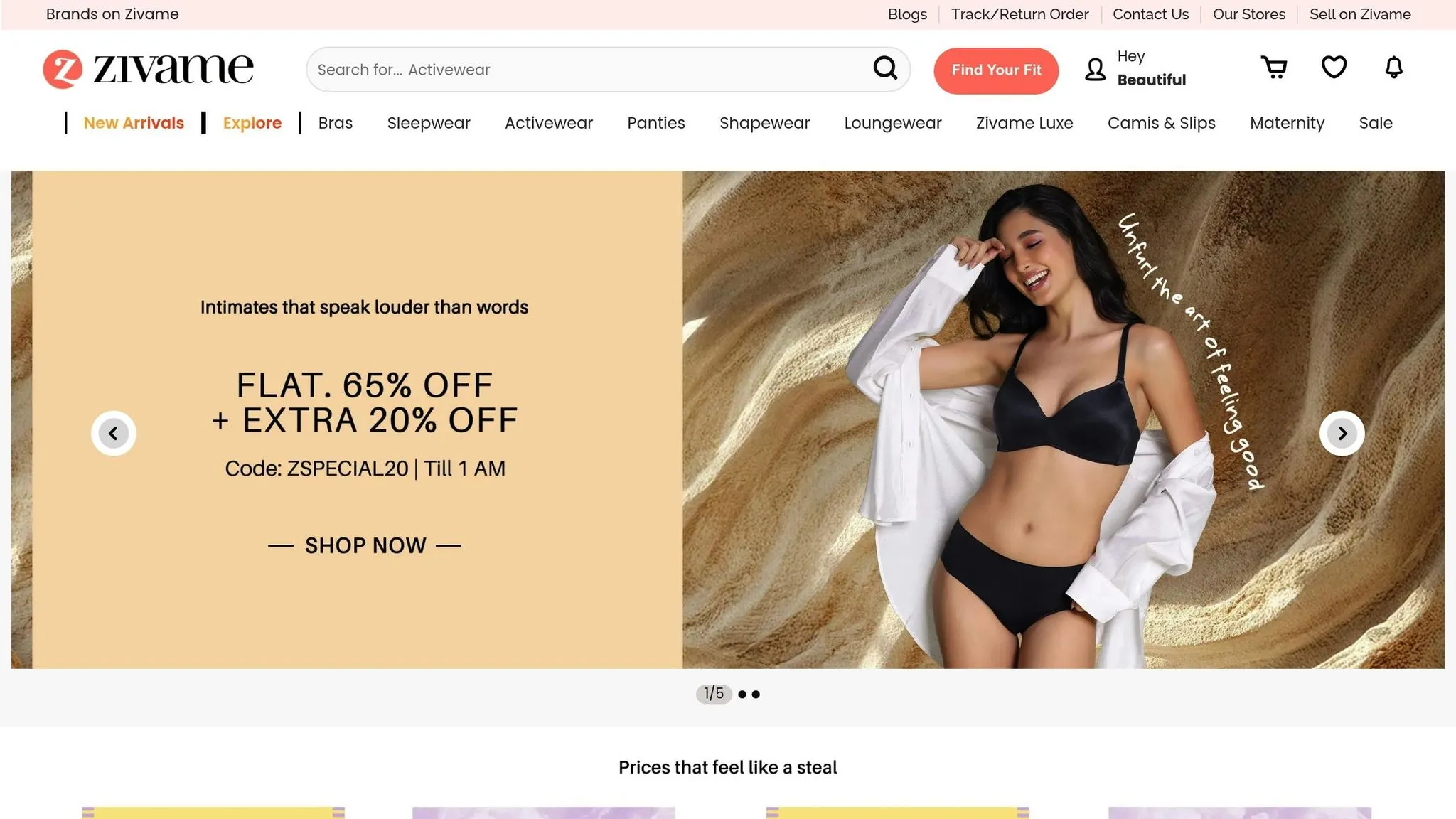
Zivame is a leading D2C intimatewear brand in India, reshaping the way intimatewear is sold with a strong digital focus and an extensive portfolio of over 50,000 styles. From lingerie to sleepwear, shapewear, and activewear, Zivame offers products in more than 100 sizes, making it a go-to destination for diverse needs. Its position in the market is further bolstered by solid backing from major investors.
Major Funding Rounds and Investor Support
Zivame’s journey took a pivotal turn in 2020 when Reliance Retail acquired the company for around ₹1,200 crore (approximately US$160 million). Mukesh Ambani, chairman of Reliance Industries Ltd., highlighted the importance of this acquisition, saying:
“Our investment in Zivame reinforces our commitment to expanding this category.”
This partnership has enabled Zivame to grow its operations significantly, reaching both metropolitan areas and Tier 2 and Tier 3 cities. The timing couldn’t be better, as the Indian intimatewear market is expected to grow to ₹75,466 crore by 2025, with women’s innerwear and comfort wear making up 60% of the segment.
Building a Digital Community and Social Media Impact
Zivame has carved out a strong digital footprint, boasting 488K followers on Instagram and 204K subscribers on YouTube. The brand uses these platforms to educate and empower women, breaking taboos around lingerie and promoting body confidence. Topics like bra sizing, fabric selection, and support tips are regularly discussed, often in collaboration with influencers.
Notably, Zivame launched an 8-episode series titled “Unhooked”, where women shared personal stories about how wearing the right fit improved their confidence.
The brand’s marketing campaigns address common issues faced by consumers. For example, the 2016 campaign “Still Force Fitting Into The Wrong Bra?” cleverly used relatable analogies to highlight the discomfort of ill-fitting bras. More recently, in 2023, the #MeetYourRightFit campaign featured striking billboards in cities like Mumbai, Delhi, and Pune, showcasing the importance of comfort and proper fit.
Expanding Categories and Product Innovation
Zivame has successfully addressed a critical issue - over 70% of women wear the wrong bra size - by using consumer insights and technology. This approach has helped the brand capture 30–40% of the online lingerie market .
While lingerie remains its core offering, Zivame has diversified into activewear, sleepwear, shapewear, and swimwear. Its innovative products include the Fitcode for precise sizing, the True Curve line for curvier women, lightweight Miracle bras, mastectomy bras for survivors, and the inclusive Rosaline range .
The brand is also expanding its offline presence. In June 2025, Zivame opened its first franchise store in Madurai, Tamil Nadu. CEO Lavanya Pachisia explained the strategy behind this move:
“Expanding via local franchise partners deepens our presence and tailors the Zivame experience to local preferences.”
Pachisia also emphasized the brand’s dedication to educating consumers:
“Zivame will continue to invest in consumer education because, as a brand and a category leader, we bear the responsibility of guiding consumers towards the right fit and addressing common challenges. The market is vast, with room for more players to enter. We are just scratching the surface and there’s more potential ahead.”
23. Clovia
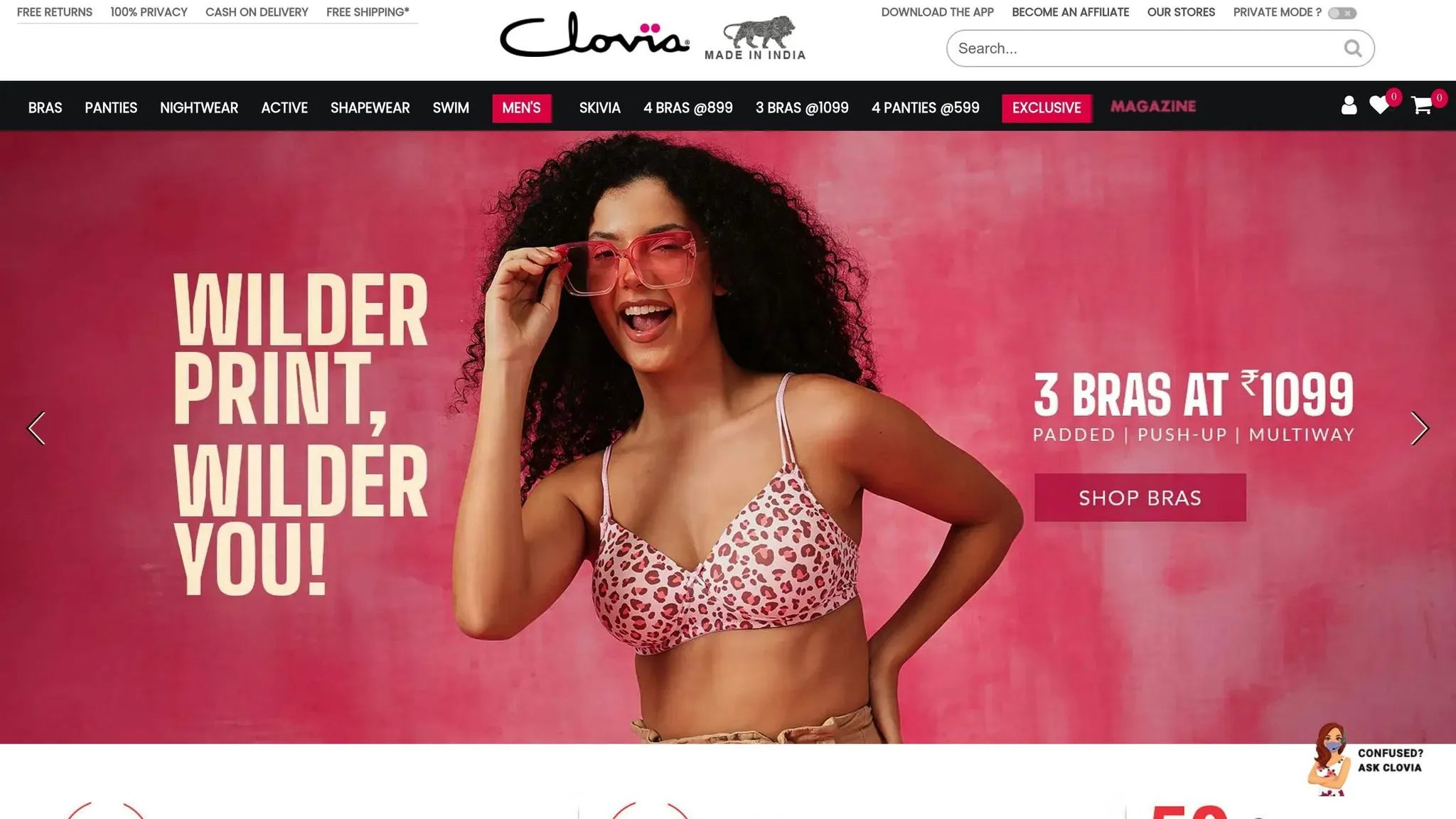
Clovia has quickly risen as one of India’s most dynamic direct-to-consumer (D2C) lingerie brands, reshaping how intimate wear is perceived. While older brands often stuck to plain, functional designs, Clovia dared to ask, “Why not add polka dots, vibrant florals, and tailored cuts for every body type?” This fresh perspective has earned the trust of over 50 lakh women across India, driving its impressive growth.
Impressive Revenue Growth in Recent Years
Clovia’s revenue from operations jumped by 70% in FY23, reaching ₹291.71 crore compared to ₹171.16 crore in FY22. The brand adapted to changing consumer needs during the pandemic by expanding into loungewear, activewear, and nightwear, which fuelled its digital-first growth strategy. By FY20, Clovia had already achieved a 50% year-on-year growth, with 85% of its sales coming from digital channels. Today, the brand sells between 6–7 lakh pieces monthly - roughly one every three seconds - and a significant portion of its revenue (about 65%) now comes from non-metro cities.
Strategic Investments and Major Funding
A turning point for Clovia came in March 2022 when Reliance Retail acquired an 89% stake in its parent company, Purple Panda Fashions, for ₹950 crore. This financial boost allowed Clovia to scale rapidly, placing it alongside other well-known intimate wear brands under Reliance’s umbrella. The infusion of capital also enabled Clovia to amplify its digital marketing efforts.
A Bold Digital and Media Strategy
Clovia’s quirky, meme-driven Instagram content has helped it build a strong online presence. In December 2022, the brand made its television debut with Shraddha Kapoor as its ambassador. The campaign doubled Google searches, tripled offline store visits, and significantly boosted brand awareness. As Nikhil Gulati, Clovia’s General Manager of Marketing, explained:
“Being associated with Shraddha Kapoor, who happens to be the most followed Bollywood actress, has made the conversation around lingerie at least mainstream in the media and also has given us robust television and has given us access to the households.”
The brand has also embraced reality TV and influencer marketing, collaborating with Bigg Boss contestants and personalities like Khanzaadi and Sana Makbul to connect with urban millennial women. This digital momentum has allowed Clovia to continually expand its product range to meet the evolving needs of its customers.
Expanding Categories and Product Offerings
Clovia’s success lies in its deep understanding of the intimate wear market. With over 1,000 styles in more than 50 sizes designed for nine different Indian body types, the brand ensures inclusivity. In September 2024, Clovia launched its first collection of plus-size bras, catering to women with sizes ranging from 32B to 44F.
Beyond lingerie, Clovia has diversified into adjacent categories. It introduced Skivia for women’s hygiene and personal care, John Player for men’s innerwear, and Clovia Cubs for kids’ nightwear. The brand keeps its inventory fresh, introducing over 200 new styles every month, with 75% of its stock being less than 30 days old. Pankaj Vermani, Clovia’s CEO and founder, highlighted the brand’s growth strategy:
“Our categories are essential products in the wardrobe and work-from-home has given a further boost to the sales both for innerwear and our loungewear. Activewear is also coming up as one of the core categories for us. In the next 2–3 years, we plan to continue to grow from strength to strength on the back of category growth, and product innovation.”
With ambitious plans to reach 50 million customers over the next four years, Clovia is poised to solidify its place in India’s growing intimate wear market. Its digital-first approach and innovative product strategies highlight the potential for brands to thrive in a competitive space.
Discover 1300+ Indian D2C Brands
D2CStory is the ultimate discovery platform for sales and marketing teams. Filter by category, social following, and more to find your next customer.
Get Started for Free
FAQs
What is driving the rapid growth of India’s D2C market, and how are brands using digital strategies to succeed?
India’s D2C market is experiencing rapid growth, fuelled by expanding internet access, rising disposable incomes, and an increasing familiarity with digital platforms. These changes have made online shopping not just easier but also more attractive to a broader audience.
Brands are excelling with digital-first strategies that prioritise hyper-personalisation, active community engagement through user-generated content, and collaborations with influencers. They’re also tailoring products to local preferences and using data analytics to fine-tune their marketing efforts. By blending creative campaigns with a customer-first mindset, these brands are redefining standards in the Indian market.
How do brands like Sugar Cosmetics and Mamaearth stay ahead in the competitive beauty and personal care market?
Brands like Sugar Cosmetics and Mamaearth have carved a strong niche in the beauty and personal care market by focusing on consumer-driven strategies, innovative products, and distinct brand identities.
Sugar Cosmetics connects with modern, tech-savvy consumers by offering high-quality, cruelty-free products that deliver an affordable touch of luxury. The brand stays ahead by actively using social media, collaborating with influencers, and consistently introducing fresh products to the market.
Mamaearth, in contrast, stands out with its emphasis on natural, toxin-free products that resonate with eco-conscious buyers. By addressing unmet needs in the market and integrating customer feedback into their product development, Mamaearth ensures its offerings remain relevant. Both brands thrive on quick product rollouts and sharp marketing tactics, helping them maintain a strong foothold in India’s rapidly expanding beauty industry.
How do funding and investor support drive the growth of successful Indian D2C brands like Lenskart and BlueStone?
The Impact of Funding on Indian D2C Brands
Strong financial backing and investor support have been instrumental in the growth of Indian direct-to-consumer (D2C) brands like Lenskart and BlueStone. Take Lenskart, for example - it has raised over ₹9,300 crore since 2021. This funding has allowed the brand to invest in advanced technology and expand its footprint, not just in India but globally as well. Similarly, BlueStone secured ₹590 crore in Series D funding, enabling it to diversify its product range.
This kind of financial support provides these brands with the muscle to scale up their operations, improve marketing strategies, and innovate their product lines. The combination of capital and strategic insights from investors often gives them the edge needed to thrive in a highly competitive market.